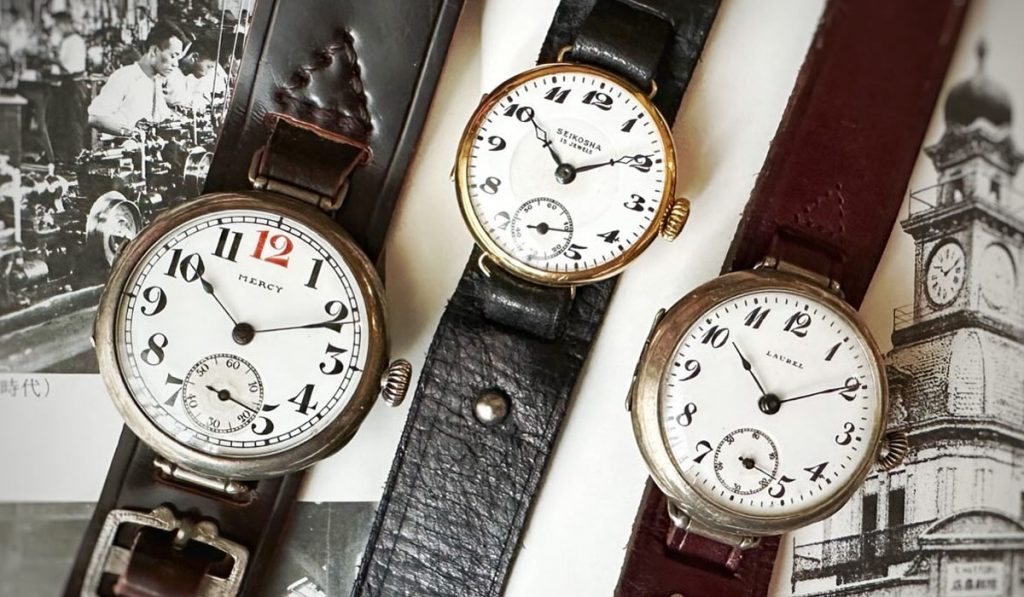
The history of Japanese wristwatches begins around 1913. The Hattori (Seiko) group had established itself as one of the most important dealers and manufacturers of timepieces in Japan, and at the Seikosha factory, founded in 1892, various pocket watch models were already in production.
With the arrival of wristwatches from Europe and America on the market, and the gradual rise in popularity of these products, which were a novelty compared to pocket watches at the time, the Hattori group decided to start producing their own models to compete.
In the first phase, up until 1923, the wristwatches produced by Seikosha were all based on previous pocket watch models (Empire, Laurel, and Mercy).
In 1924, while dealing with the destruction and significant losses caused by the Great Kantō earthquake, the first watch to feature the Seiko brand on the dial was introduced, also being the first to use a native wristwatch movement.
From this point began a second phase, in which smaller movements were produced in increasing numbers, with a proliferation of different shapes and styles that reached their peak in the 1930s, when Seiko became the largest watch manufacturer in the world, surpassing the American group Waltham and the Swiss Omega-Tissot (Société Suisse pour l’Industrie Horlogère).
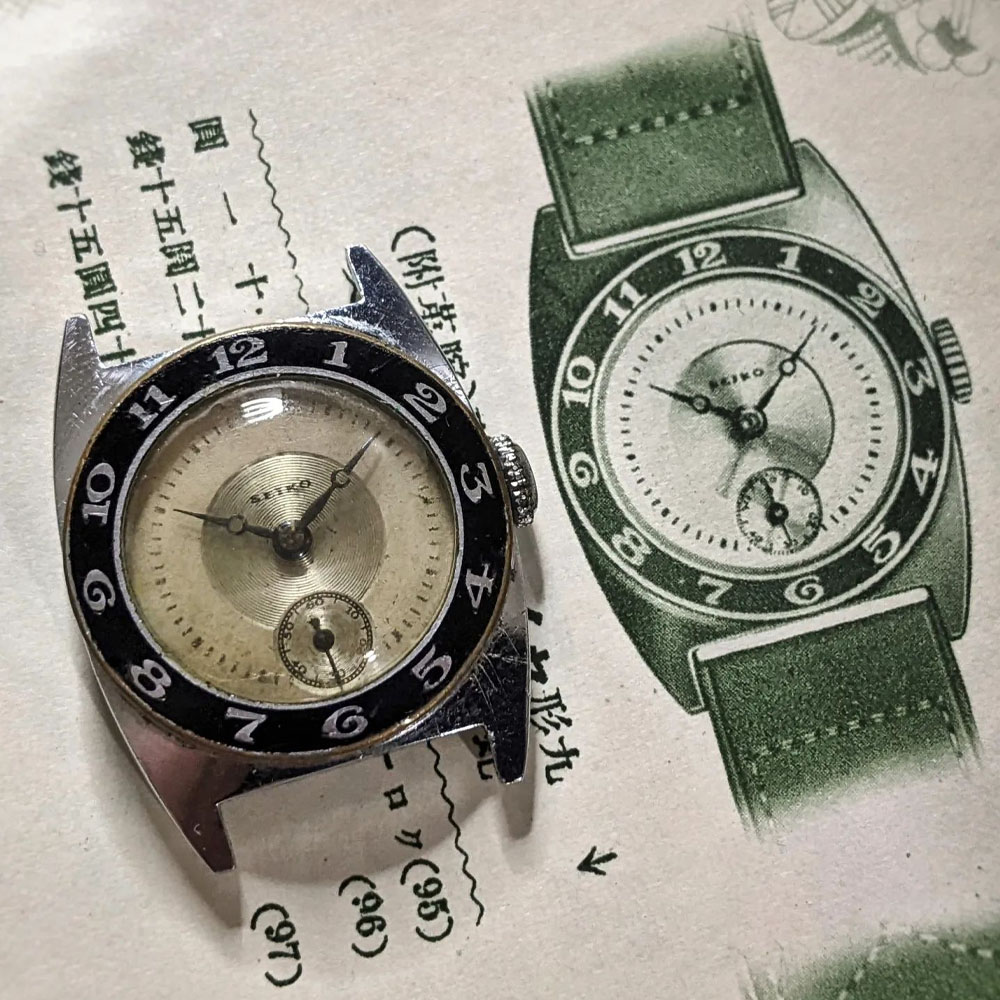
With the outbreak of World War II, the group was forced to convert much of its production from timepieces to armaments, but despite the drastic decline, some watches continued to be produced.
Starting from the post-war period, production resumed growth and new successful models were introduced, which helped the company restart at a fast pace. In this third phase, the foundations were laid for the development and launch of the Marvel, the first Seiko wristwatch with an entirely in-house developed movement, marking the beginning of a new great era for Japanese watchmaking.
Empire 16 ligne wristwatch
Introduced around 1913, the Empire 16 ligne wristwatch derives from the 1909 Empire pocket watch. It is the first Seiko wristwatch, not to be confused with the Laurel, which has been mistakenly credited as the first.
The movement of the Empire is based on the structure of a popular pocket watch caliber by Moeris, a Swiss group that had long-standing relations with the Hattori. According to price lists from the time, the movable-lug case was available in nickel or silver, like the following example in the photo.
The Empire wristwatch seems to have been produced for a very short period and in few examples, making it almost unfindable today.
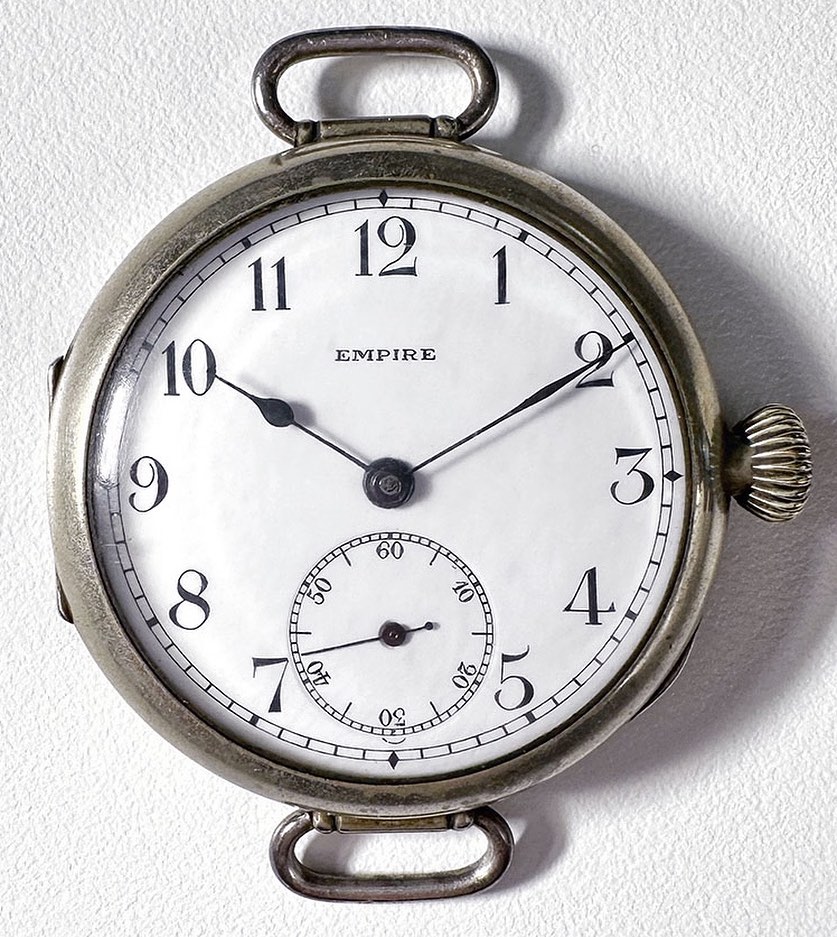
Laurel 12 ligne wristwatch (Lofty)
The Laurel wristwatch, initially appearing in catalogs under the alias Lofty, was introduced in 1915, and is based on the 1913 Laurel 12 ligne pocket watch.
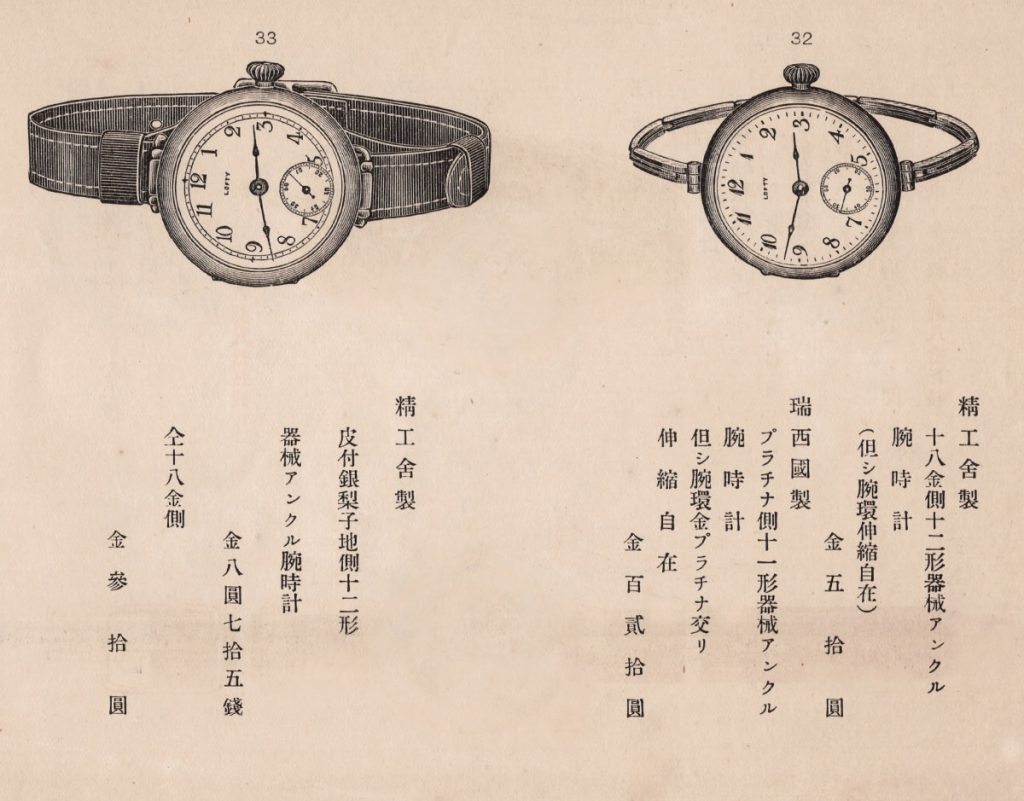
The movement structure is similar to that of some A. Schild calibers, another Swiss company with which the Hattori group appeared to have agreements. Most examples had 7 jewels, but some with 10 jewels can also be found.
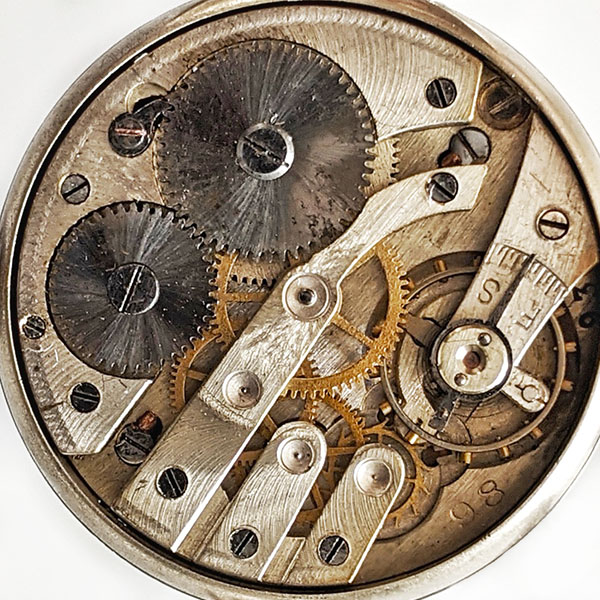
The initially used case was of the movable-lug type, very similar to that of the Empire but smaller. During the production period, various types of cases were used, including fixed-lug ones, in various materials such as silver, gold, shakudō, and nickel.
The tools of the time did not allow for the production of a large number of such small watches, and it seems that Seikosha artisans could complete only a few dozen a day. However, the fact that the Laurel was produced for several years (at least until the first half of the 1920s) means that various examples still exist today, although few remain in their original condition.
For more information: The real history of the Seiko Laurel.
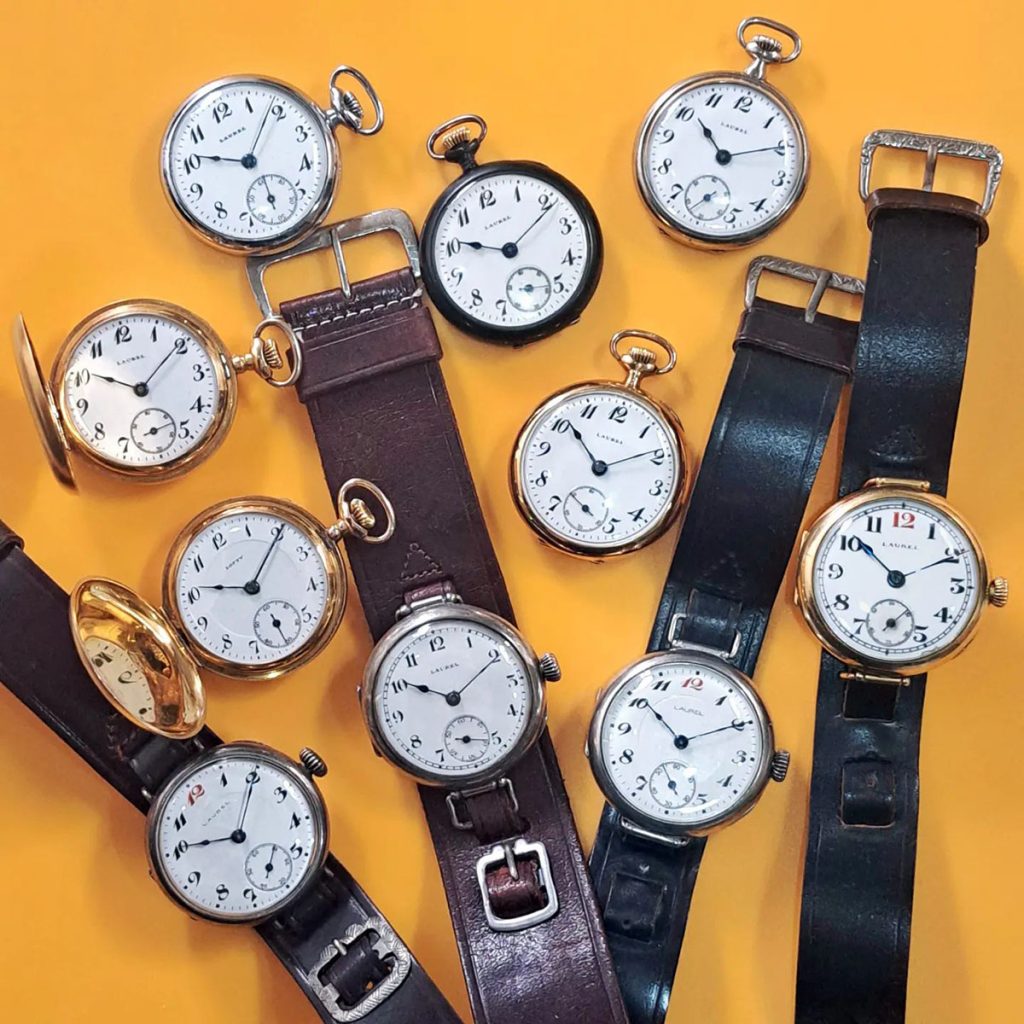
Mercy 13 ligne wristwatch
The Mercy wristwatch is the third model produced by Seikosha, derived from a 1914 pocket watch. The exact date of the wristwatch version’s introduction is unknown, but it is speculated to have been not long after the Laurel.
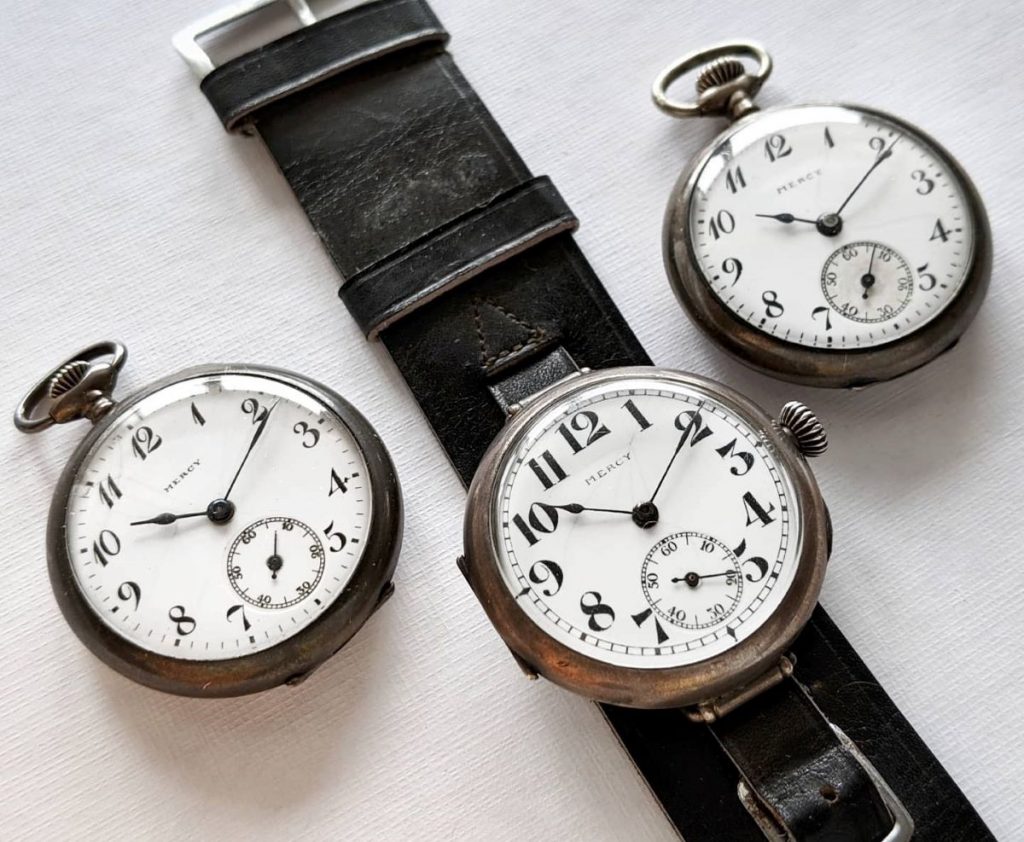
In catalogs, the Mercy was not usually depicted, but it can be found listed as a 13 ligne version of the Laurel, offered at a more affordable price. It can indeed be considered a lower-end alternative to the Laurel, with a slightly larger movement, only 4 jewels, and less refined, based on the structure of a Waltham caliber.
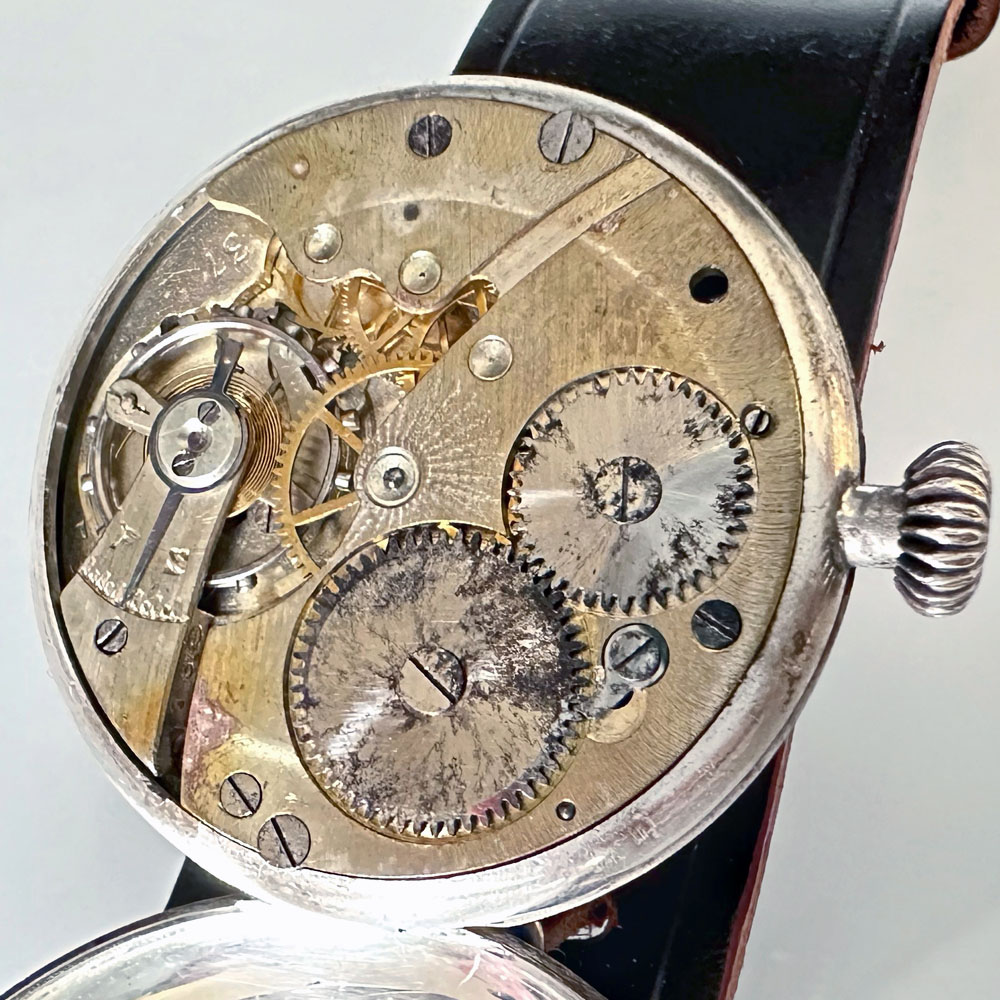
The variety of cases and materials is similar to the Laurel, starting with the silver movable-lug model. No gold versions were available for the Mercy.
Seiko-Moeris 9 ligne
In 1924, the year following the Great Kantō earthquake, the first watch to feature the Seiko brand on the dial was launched. It was also the first to have a native wristwatch caliber, rather than one derived from pocket watch models.
This model represents a true turning point for Seiko, and the fact that it is based on the structure of a Moeris movement links it to the first Empire wristwatch. However, this is a 9 ligne movement, much smaller than the Empire and other models derived from pocket watches.
The following photo shows one of the first examples, with an 18-carat solid gold case and 7-jewel movement.
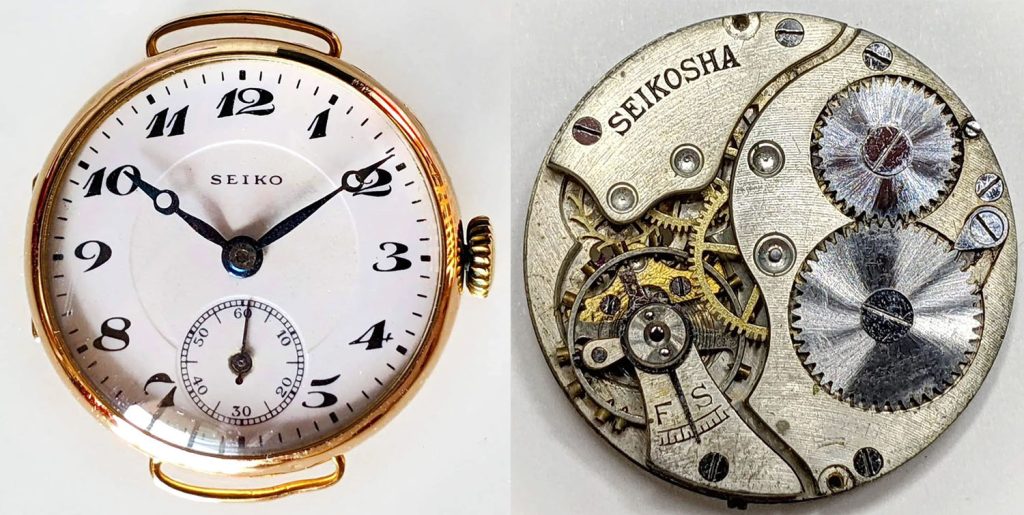
In addition to the 7-jewel version, variants with 10 jewels and the rare 15-jewel version were produced, which, as in the following examples, feature superior finishes.
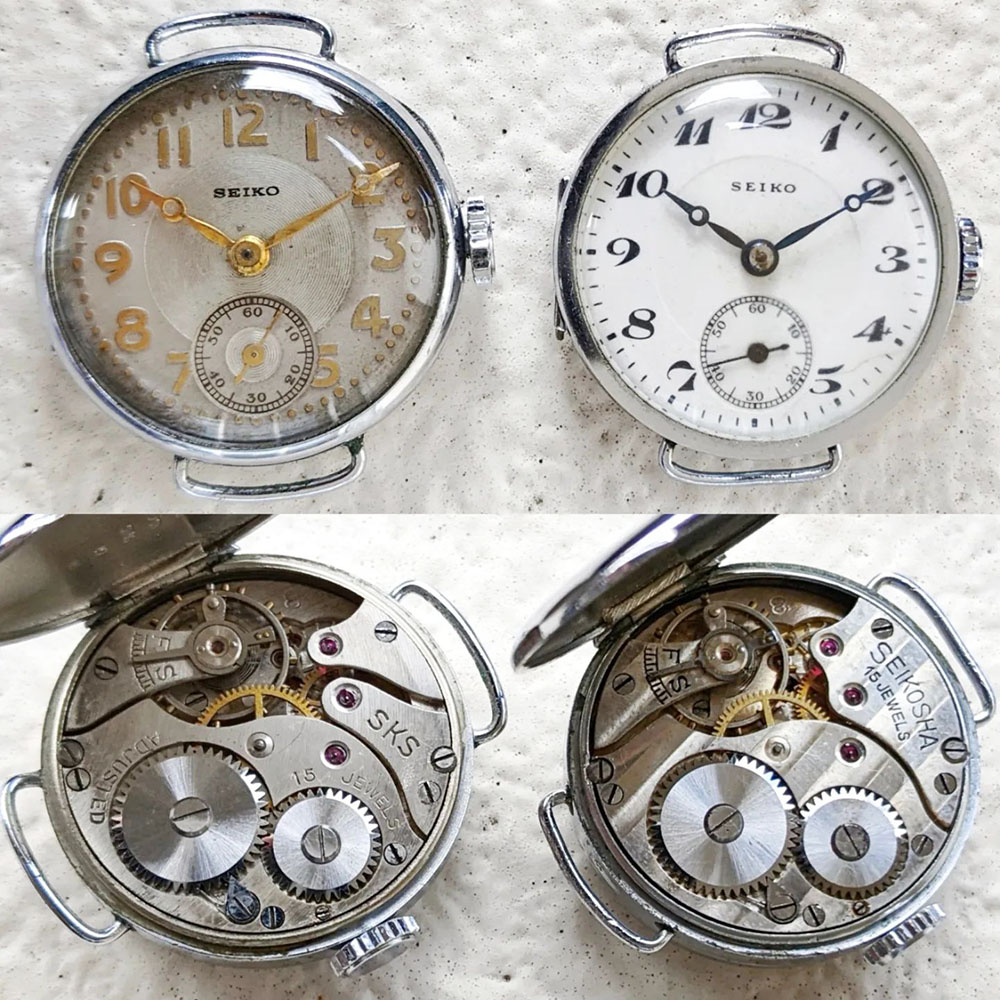
The variety of cases, designs, and materials that can be observed in catalogs is very large, especially when considering the entire production period of this movement, which was widely used until the first half of the 1940s.
The following image shows a variety of designs for Seiko-Moeris 9 ligne from the 1936 Yamada watch store catalog (the entire catalog is available here).
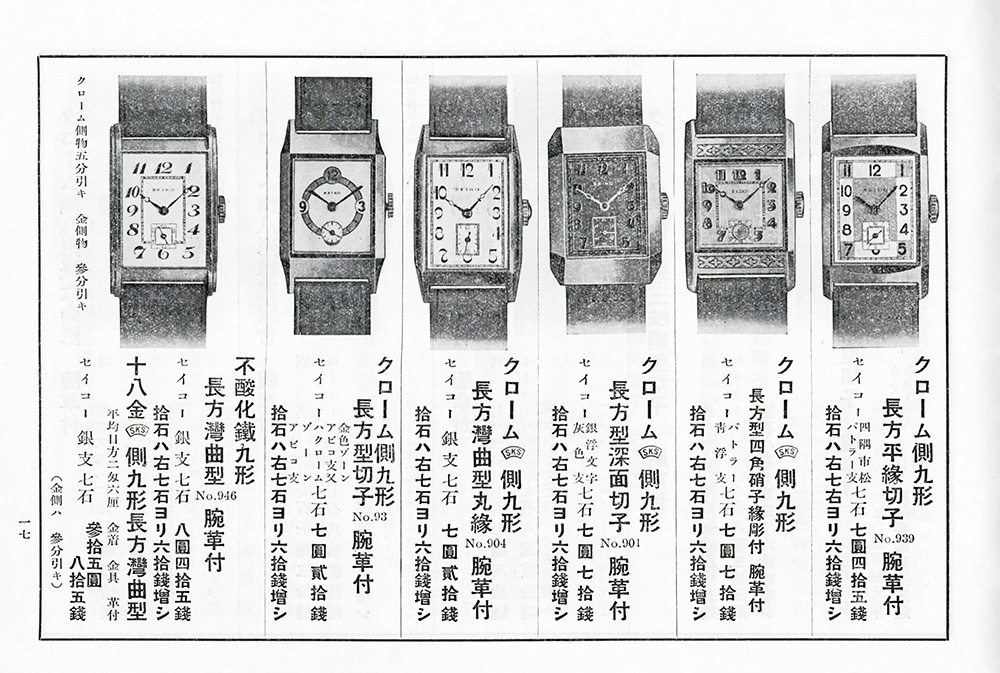
The introduction of the Seiko brand did not preclude the use of other aliases, which continued to proliferate on many of the company’s watches. Some examples of aliases associated with the Seiko-Moeris 9 ligne are Robin, State, Ruler, Speet, Venus, and the list goes on.
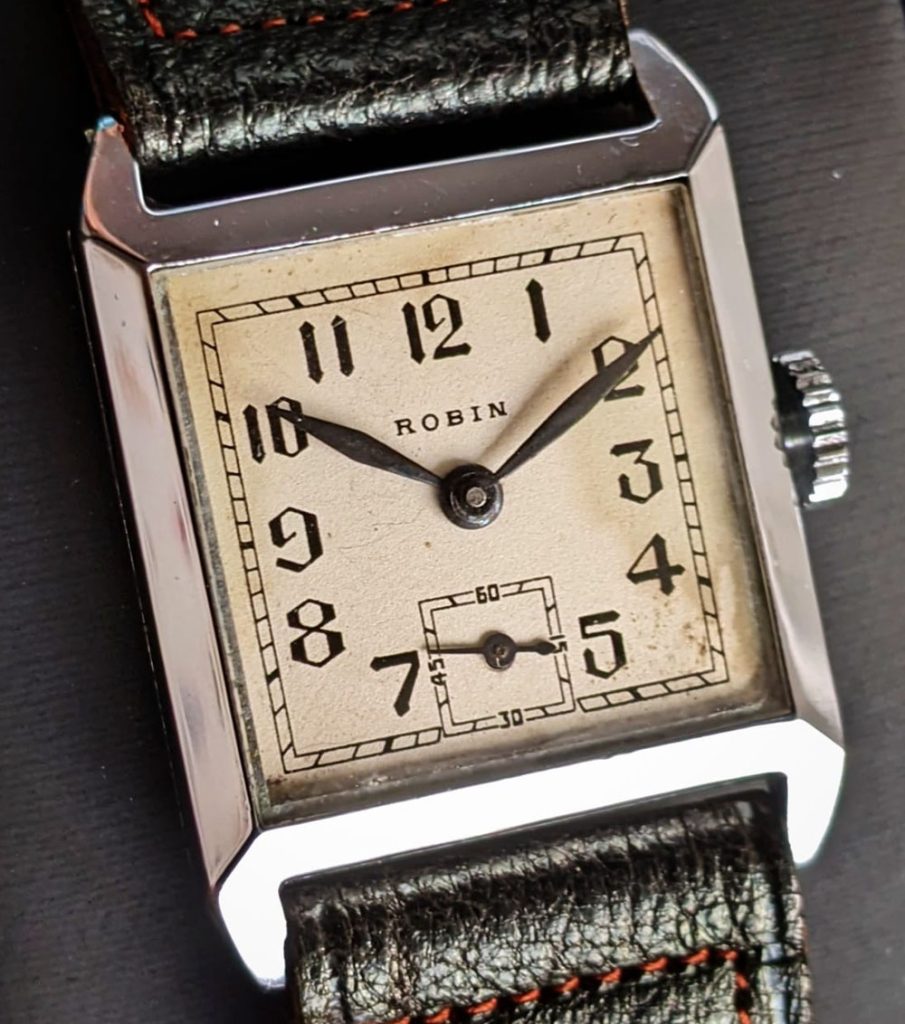
Among the variety of Seiko-Moeris 9 ligne watches, there are also some military-style models, such as this “Dust-Proof” with a double case depicted in the 1938 Hattori catalog.
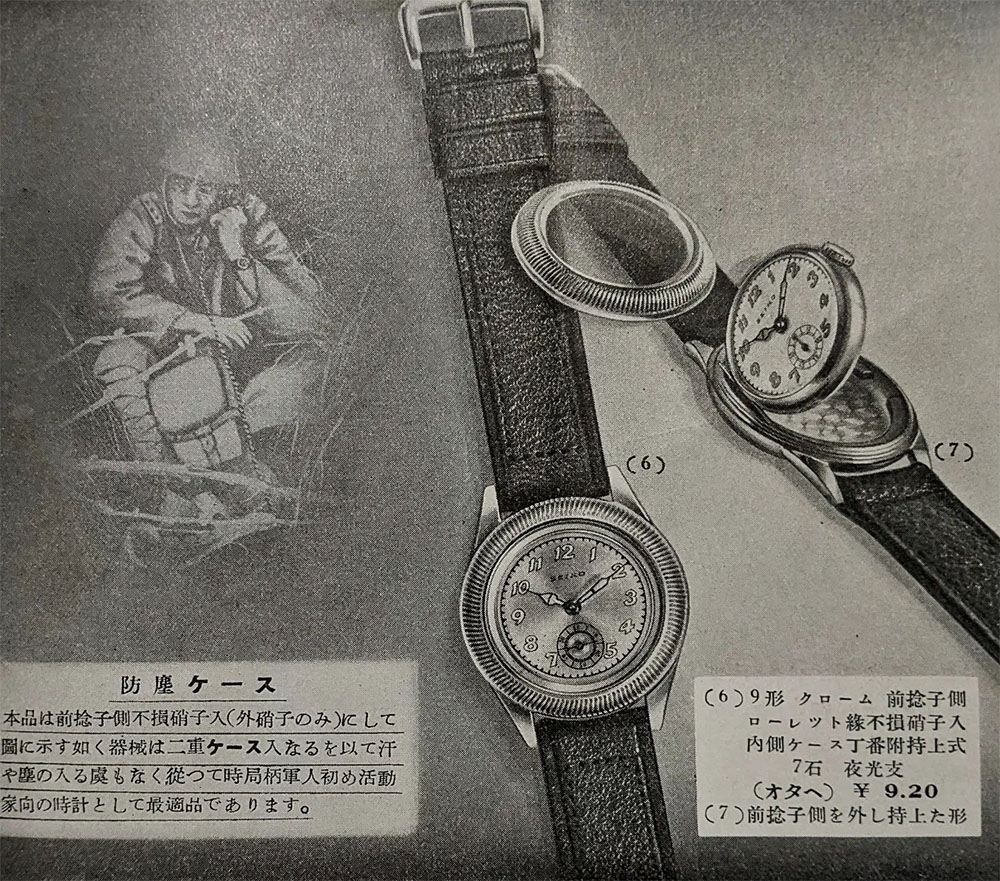
Seiko-Buren 10 ligne
The Seiko-Buren 10 ligne was produced for a short period starting in 1925, and as the name suggests, the movement structure was based on a Buren caliber.
This model is still the subject of discussion, as catalog information is scarce, and of the few existing examples, I have yet to find one that presents itself in original and unaltered condition.
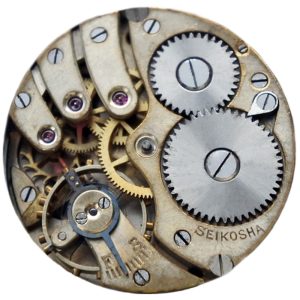
Seiko-Moeris 10 ligne
In 1926, the Seiko-Moeris 10 ligne caliber was introduced, the largest in this family of movements, although it measured only about 23 mm in diameter.
The main characteristics were similar to the 9 ligne model, with examples featuring 7, 10, and 15 jewels (the latter rarer), in various types and materials of cases.
The following is one of the rare examples featuring the “Seikosha 15 Jewels” inscription on the dial, with a 15-jewel movement and an 18-carat solid gold case.
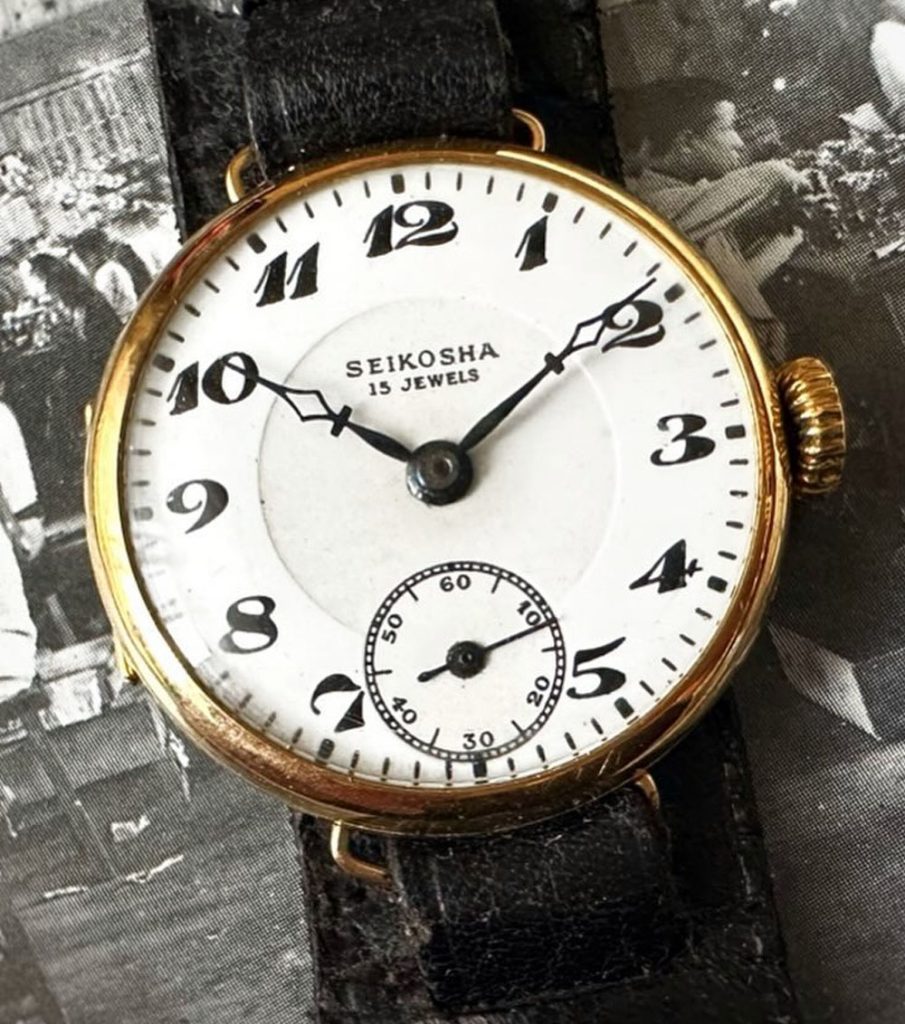
The Seiko-Moeris 10 ligne was one of the most widely used movements for Seiko men’s watches, and it is also found in most military-style watches, such as this example from the Japanese Imperial Navy associated with the Yokosuka base.
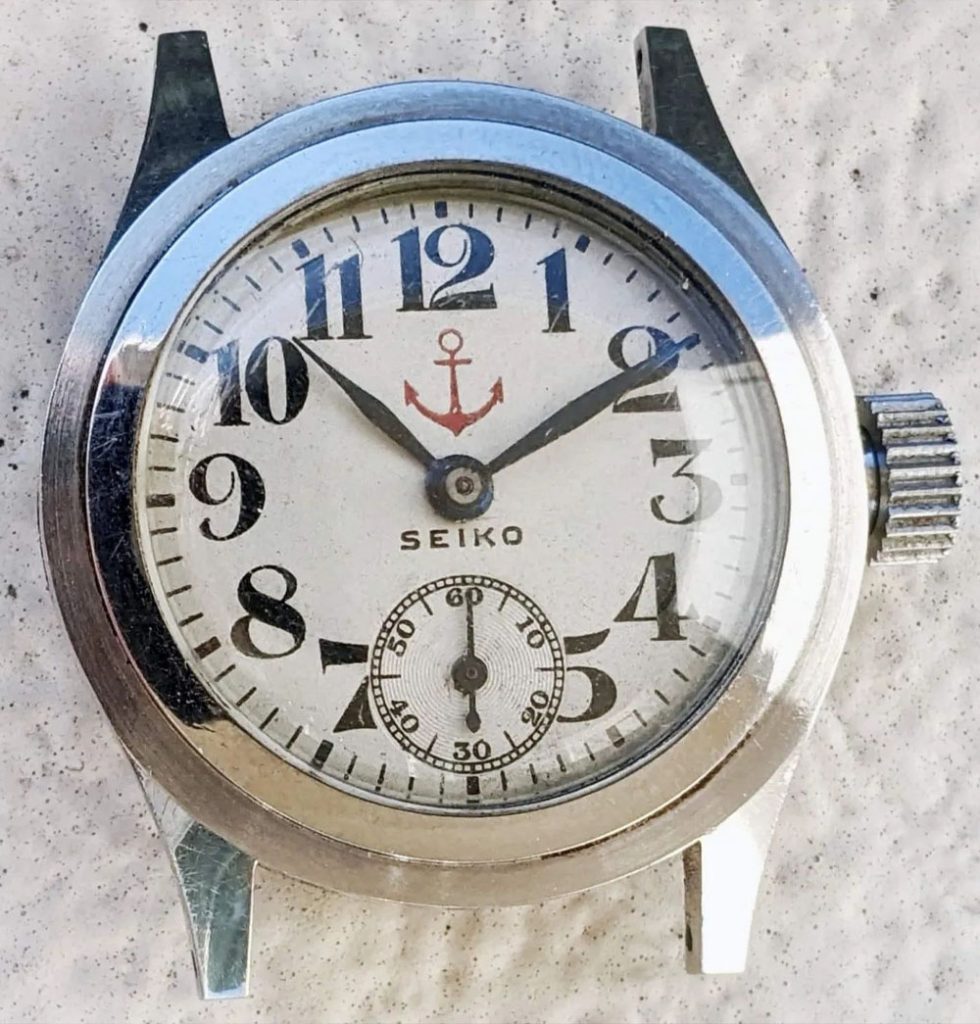
The following photo shows the double case of another military-style example, designed to protect the watch from moisture and dirt infiltration.
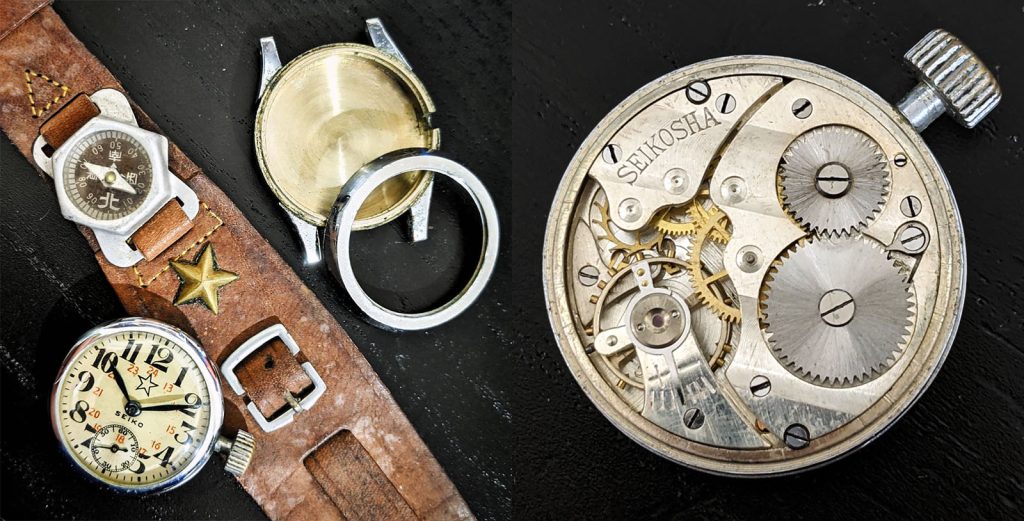
The following image is from the 1931 Hattori catalog and illustrates some of the available configurations for the Seiko-Moeris 10 ligne.
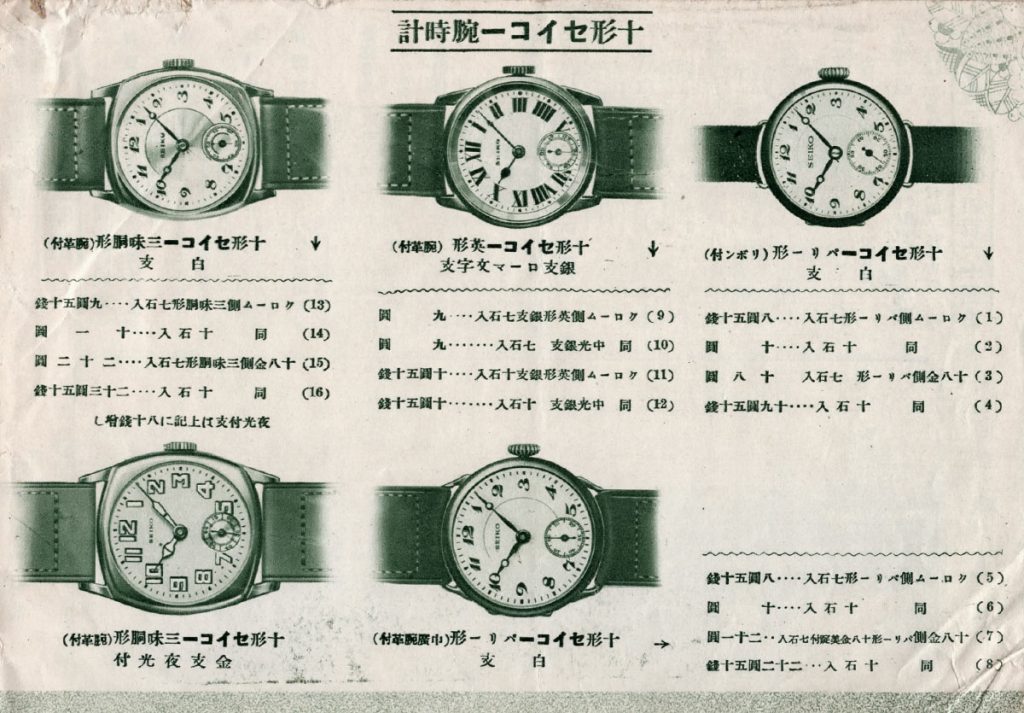
This other image is from the 1934 Hattori catalog.
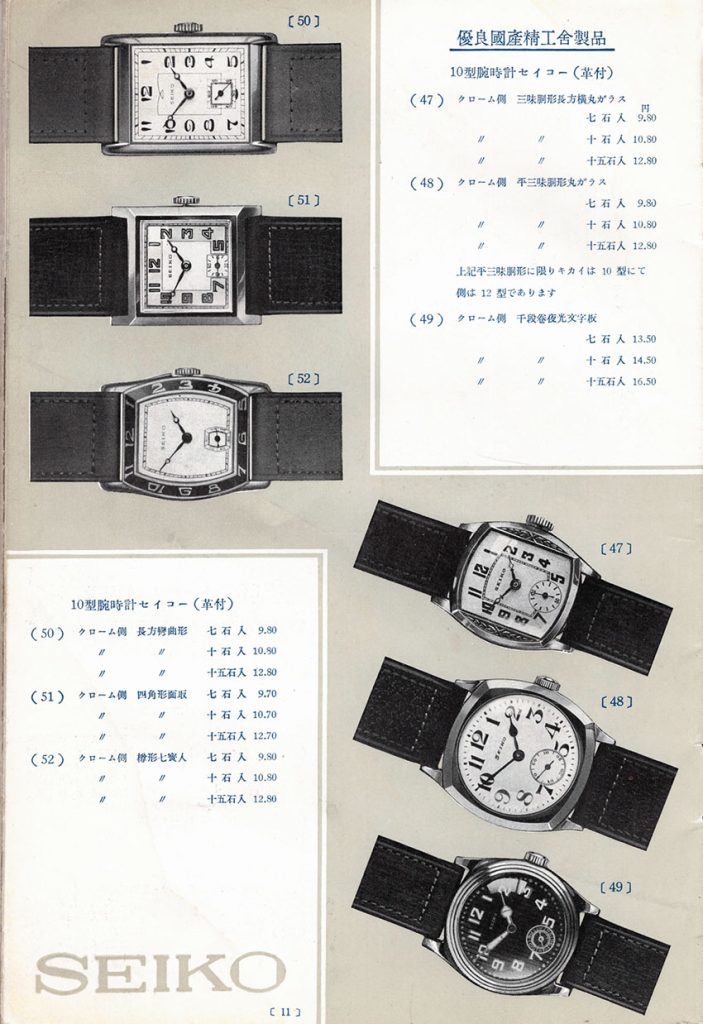
Seiko-Moeris 8 ligne
The smallest version of the three movements in the Seiko-Moeris family was introduced in 1927. The following image, from the 1931 Hattori catalog, illustrates some basic models and the 8 ligne movement.
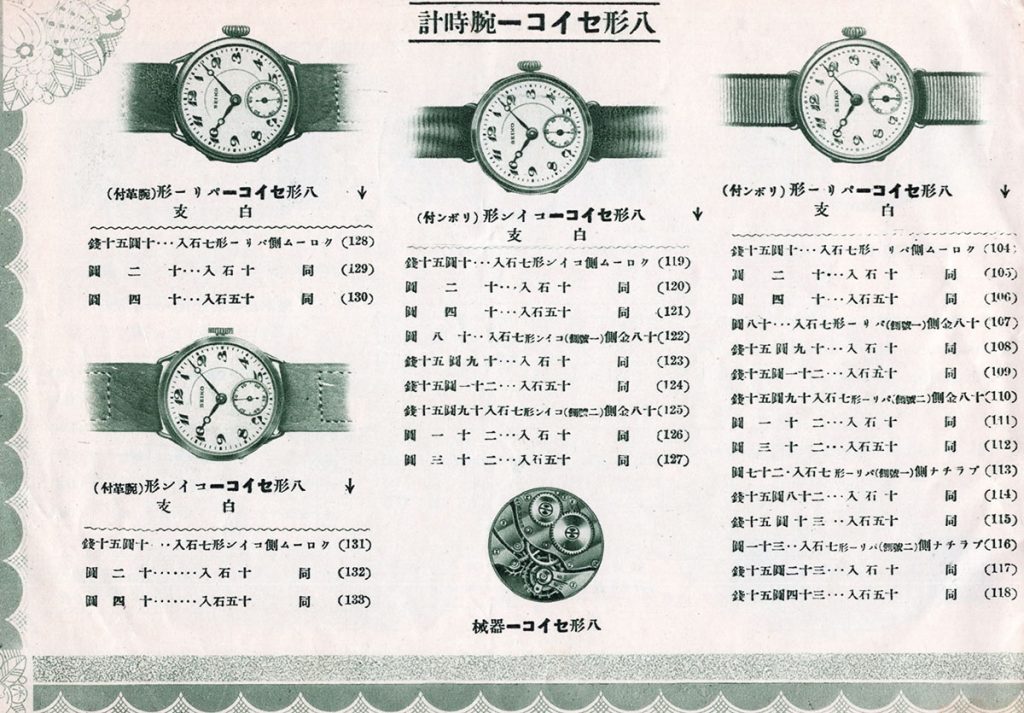
The movement was available in 7, 10, and 15 jewel versions, and in a very rare 16 jewel version that seems to have been produced later, between the late 1930s and early 1940s, generally associated with the “Seiko Special” brand, like the following 18-carat solid gold example.
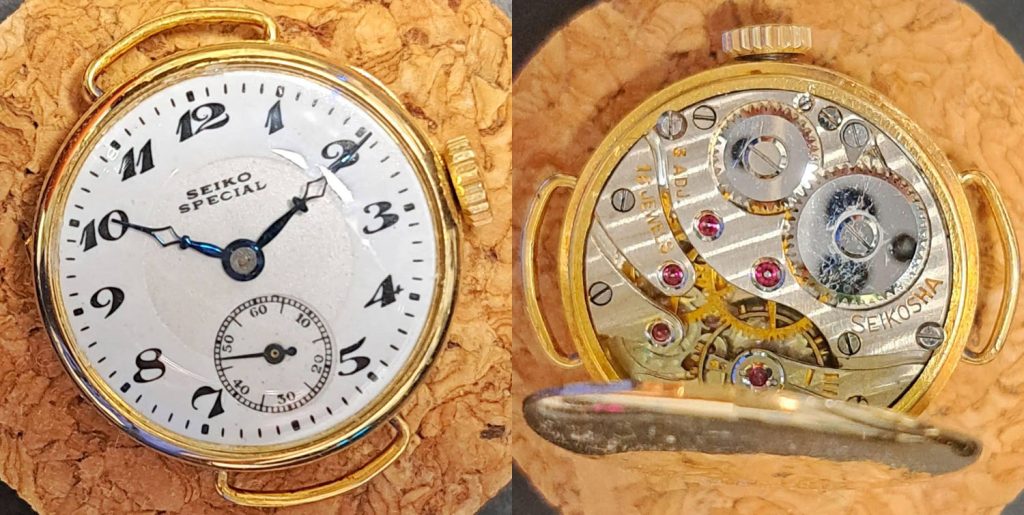
The Seiko-Moeris 8 ligne is sometimes described as the first Japanese women’s wristwatch, but many examples of unisex and men’s models can also be found.
The following is a selection from the Yamada watch store catalog (the entire catalog is available here).
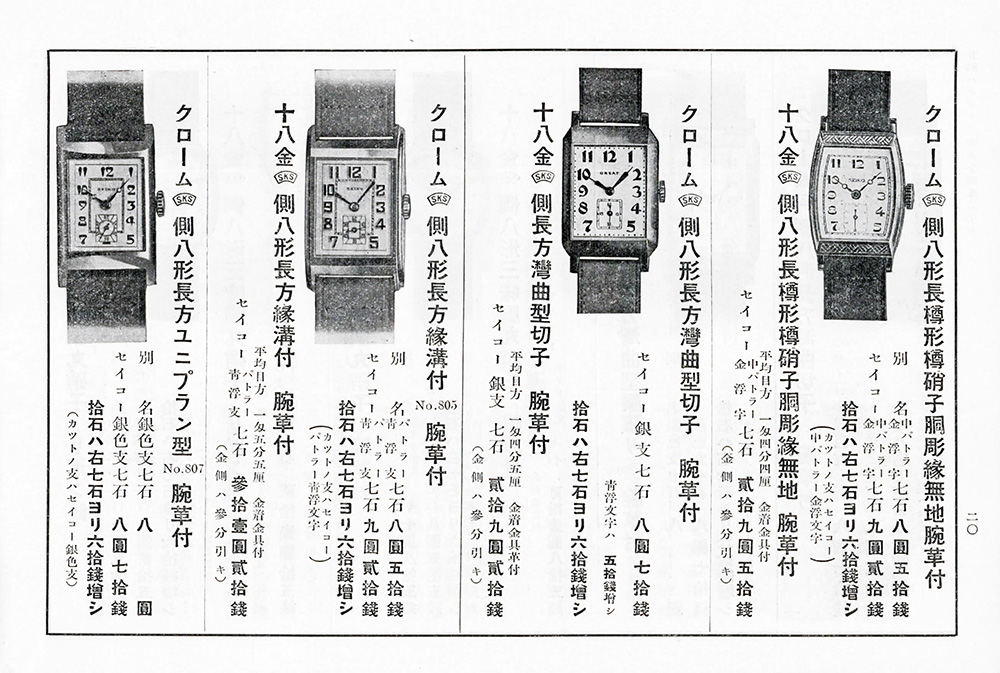
In this other image, again from the Hattori catalog, you can see an example with decorations on the side of the nickel case.
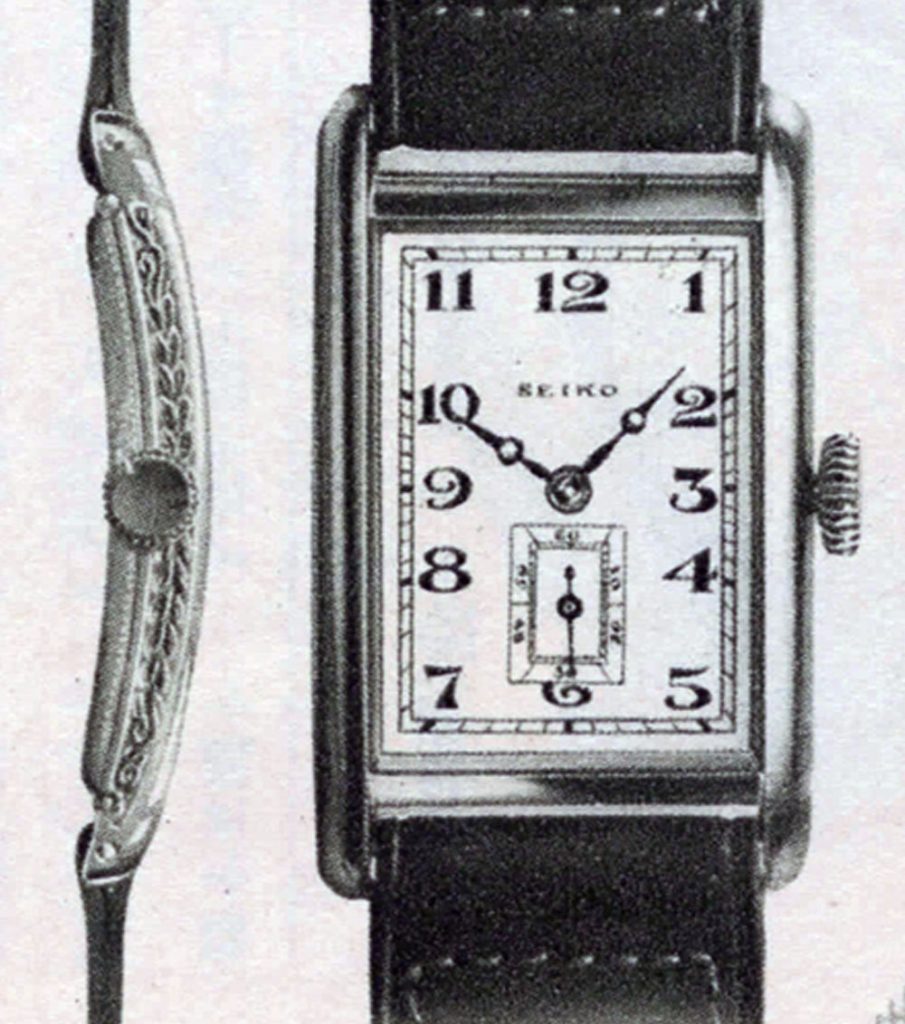
Nation 9 and 10 ligne
Starting in 1929, alongside the Seiko-Moeris, Seikosha produced another family of wristwatch movements called Nation.
The Nation were produced in 9 and 10 ligne versions, but unlike the Seiko-Moeris, which had significant differences among them, the two Nation movements appeared structurally identical and varied only in diameter.
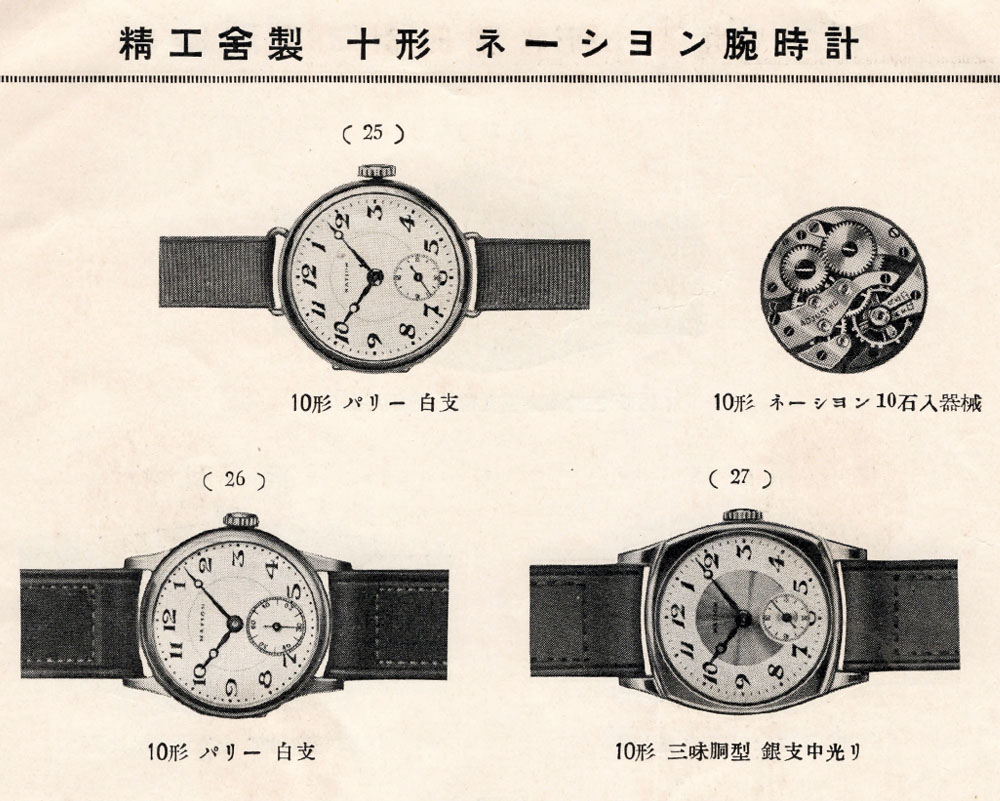
In this case, too, there are examples with 7, 10, and 15 jewels, with the latter rarer than the previous ones. The wide selection of styles and cases is immediately evident from the catalogs of the time.
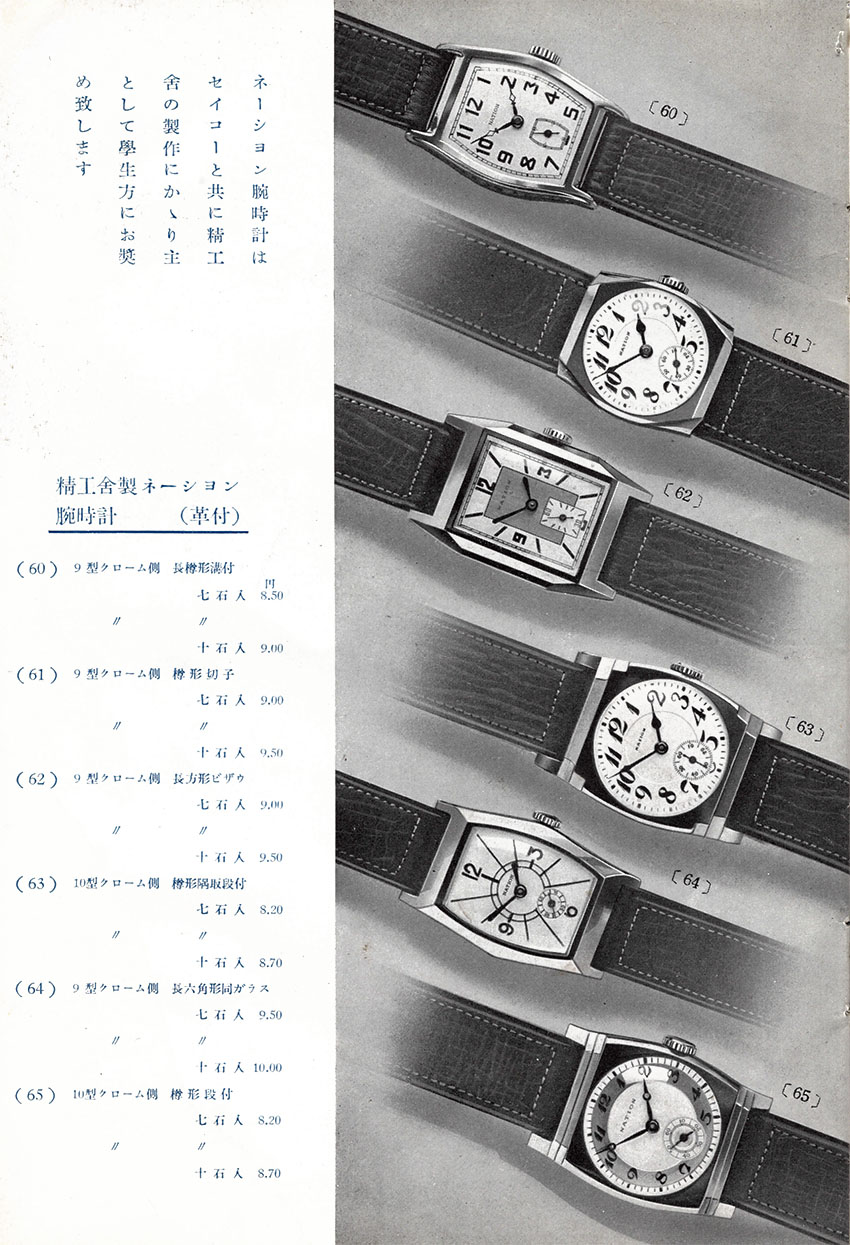
A known fact about the Nation (and Parrot) is that they were also used as supply movements for third parties, as can be seen on Chikyu watches, marketed by Yoshida (later Orient), which housed Seikosha movements.
Parrot 8 ligne
The Parrot is an 8 ligne model introduced in 1930, which can be considered a smaller version of the 9 and 10 ligne Nation, with a diameter of only 19.5 mm.
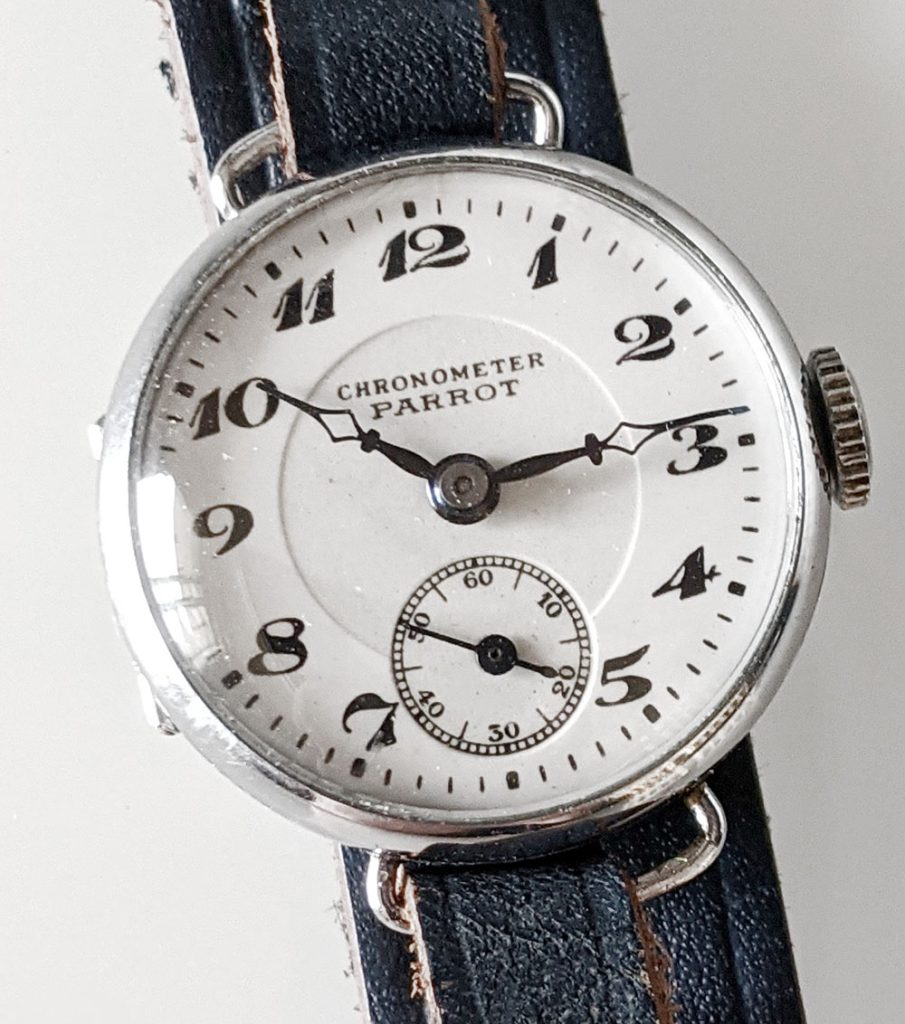
For the Parrot, versions with 7, 10, and 15 jewels existed, and watches with a remarkable variety of aliases and designs can be found.
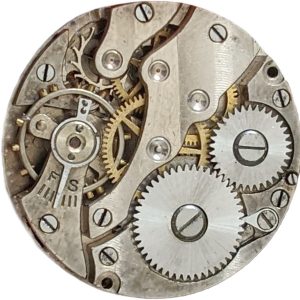
Seiko 5½ ligne
The Seiko 5½ ligne was introduced in 1931, and at the time, it was the smallest movement produced by Seikosha.
Unlike the Seiko-Moeris and Parrot 8 ligne models, which were also used for unisex and men’s watches, the Seiko 5½ ligne is found exclusively on women’s watches.
The following Seiko 5½ ligne example is from Seikosha Shiwa.
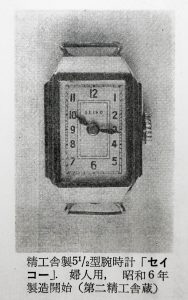
Seiko 5¾ ligne
The Seiko 5¾ ligne is a model produced from 1933 that replaced the previous Seiko 5½ ligne. In this page from the Hattori catalog, various configurations with 7 and 10 jewel movements are depicted.
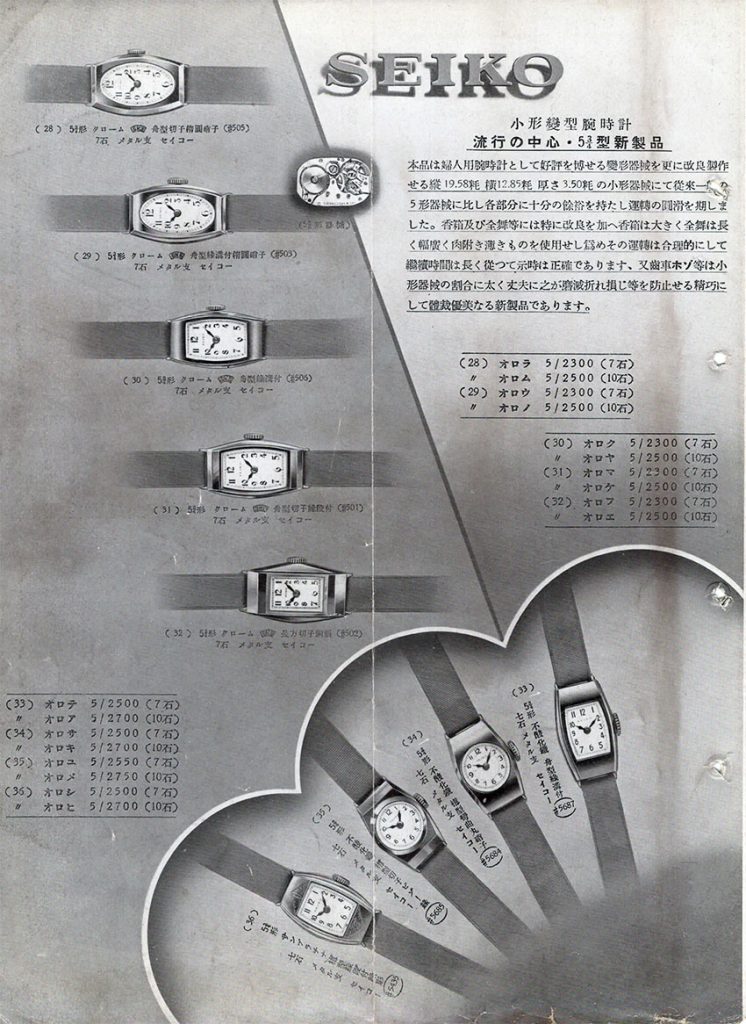
Seiko 10 ligne “Seikosha Precision”
The Seikosha Precision 10 ligne from 1939 was a high-quality watch intended for Japanese army officers. This model was delivered directly to the army and was not available for public purchase.
The 15-jewel movement, which featured high-level finishes, seems to derive from the Seiko-Moeris 10 ligne.
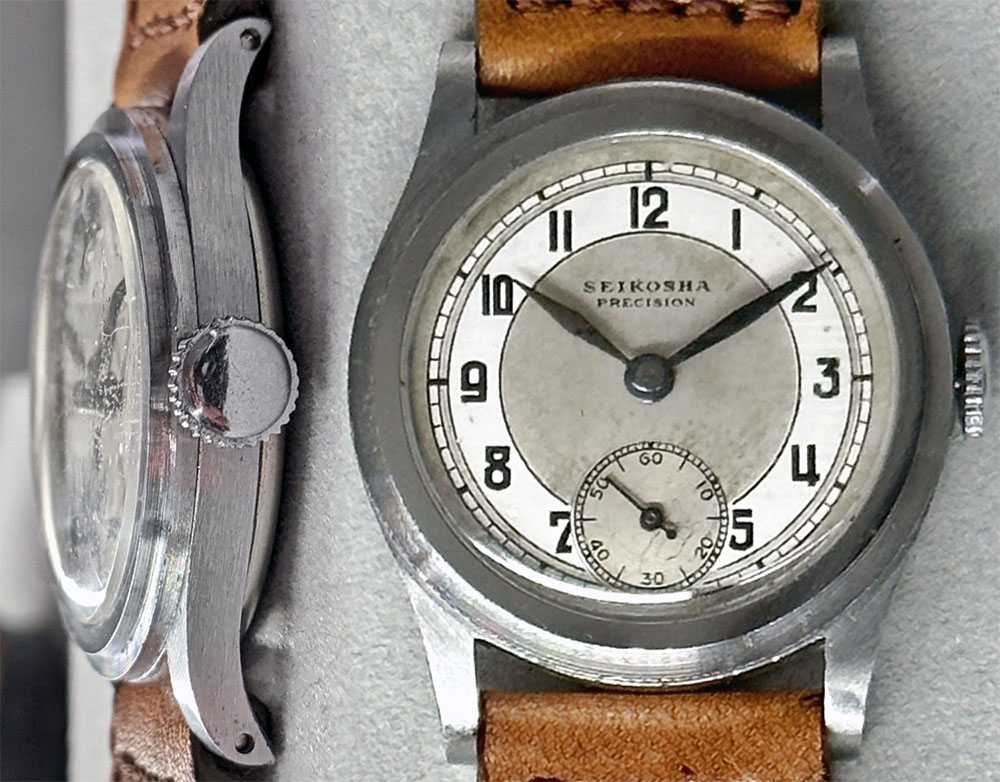
Seiko-Moeris 10 ligne central seconds
The first Japanese wristwatch with a central second hand was introduced in 1940, with a 15-jewel movement based on the structure of the Seiko-Moeris 10 ligne.
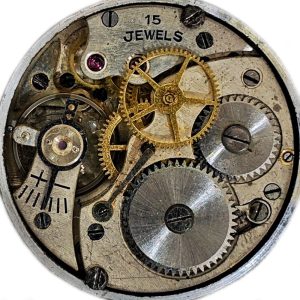
The Seikosha Shiwa book describes it as a watch for Japanese navy officers, but there are many doubts and mysteries surrounding this model.
In the rare existing examples, different aliases, uncommon configurations, and cases that seem to be of Swiss origin are noted.
For these reasons and the scarcity of information in contemporary documents, it is difficult to determine which examples are actually in original condition.
Tensoku
The Seiko Tensoku is a model produced from 1941 until the end of World War II, often associated with kamikaze pilots or more generally with Japanese army aviators.
It is a large watch, with a diameter of over 48 mm, made by adapting a pocket model with central seconds.
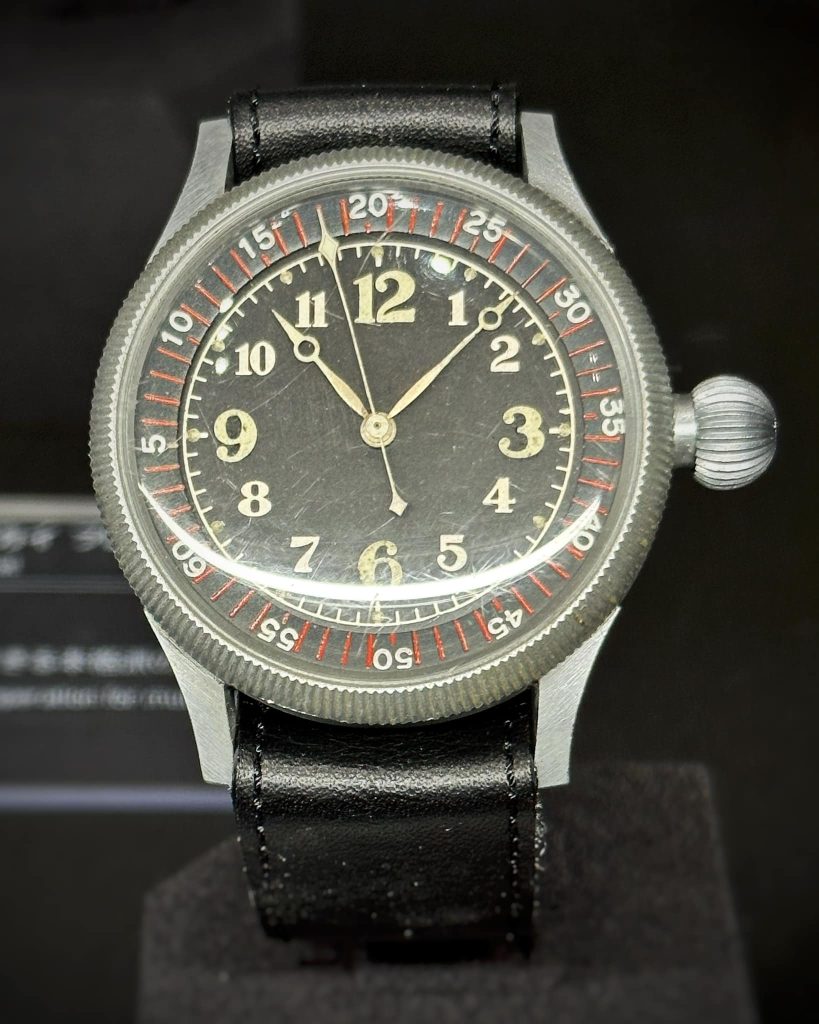
The Tensoku was produced in 15 and later 9 jewel versions. The 15-jewel models are characterized by better finishes and generally superior quality compared to the later models with fewer jewels.
Unlike the 1939 Seikosha Precision, supplied directly to the army and not available for public purchase, there is no evidence that the Tensoku was ever part of the official supply of the Japanese military.
The following photos, dating back to the first half of the 1940s, portray the Japanese Imperial Navy aviator Yukio Seki, who wore a Seiko Tensoku on his wrist.
Yukio Seki died on October 25, 1944, during his last mission, deliberately crashing his plane onto the flight deck of the USS St. Lo, becoming the first kamikaze to sink an enemy ship.
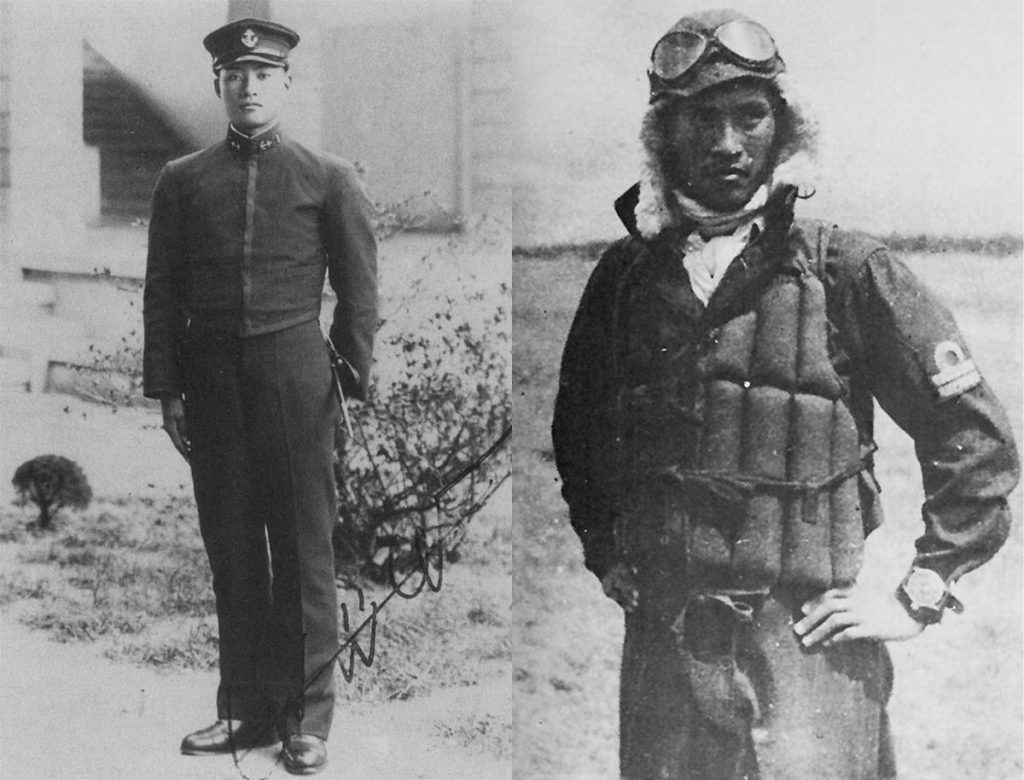
Seiko 5¾ ligne
The Seiko 5¾ ligne for women, introduced in 1946, is the first post-war model of the brand. The following example is part of the Tokyo Seiko Museum collection.
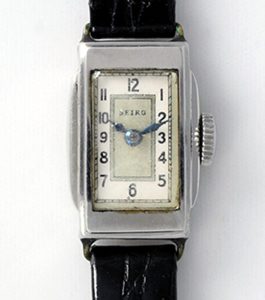
Seiko New 10A
The Seiko New 10A is a post-war model introduced in 1946, developed based on the 1939 Seikosha Precision.
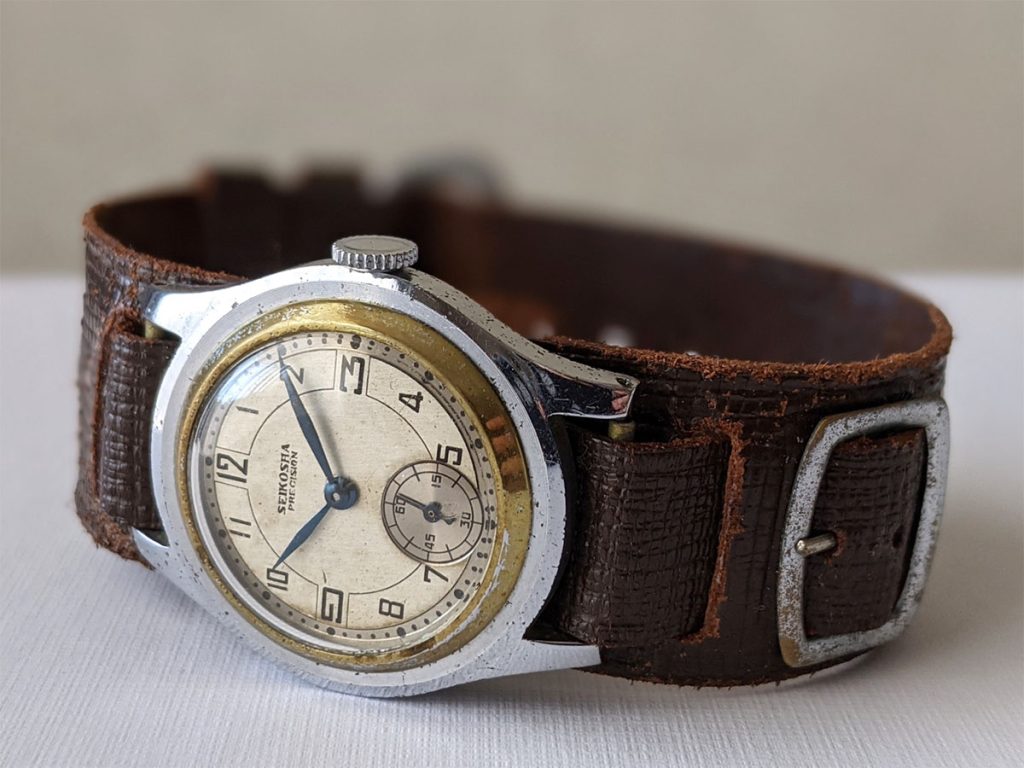
The movement, produced with 7 and 10 jewels, is nicknamed “Banana” by some for the shape of the central bridge.
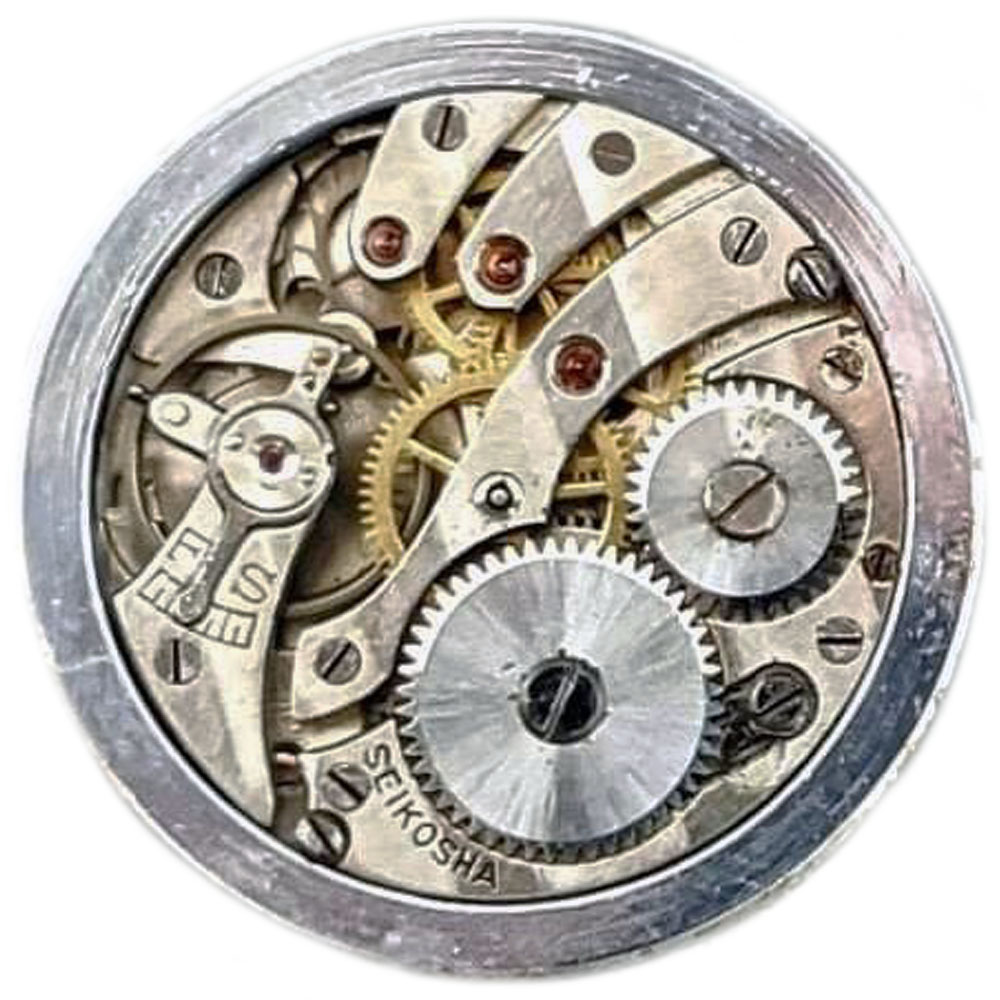
The following photo depicts another New 10A from my collection, also with the Seikosha Precision inscription on the dial.
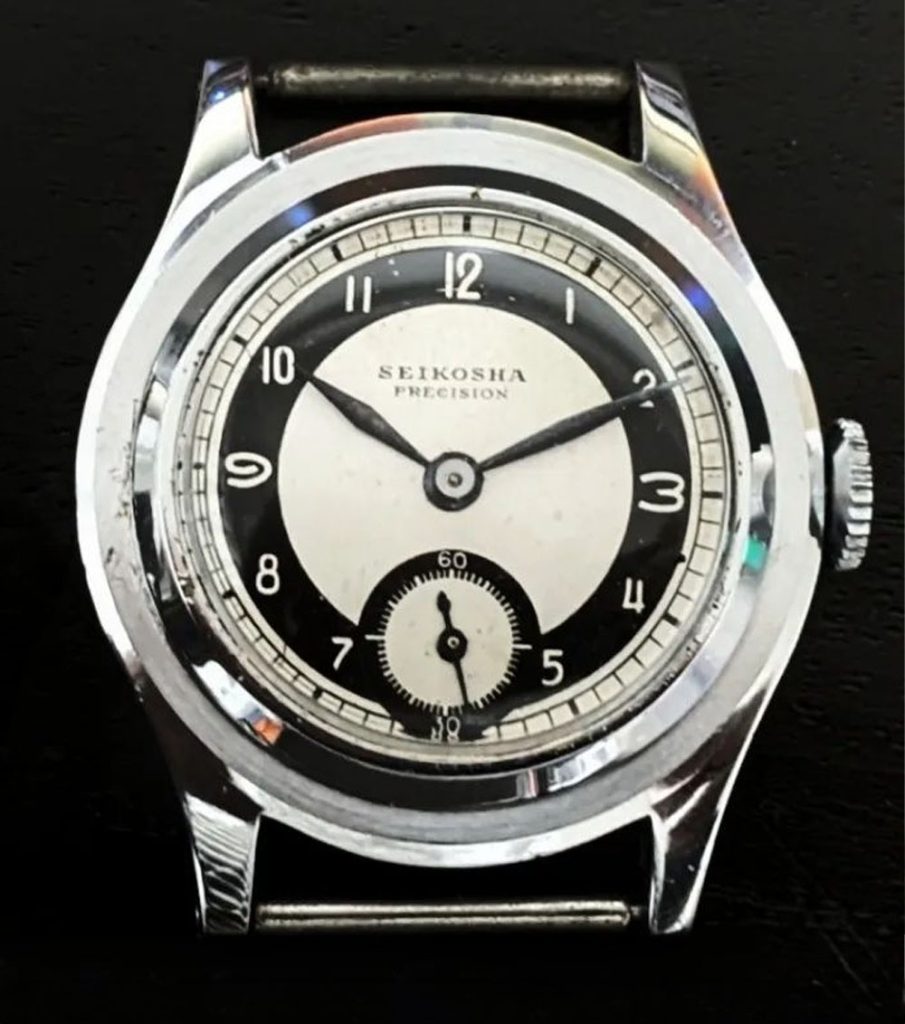
Seiko New 10A central seconds
In 1948, a central second hand model was introduced, based on the previous New 10A caliber.
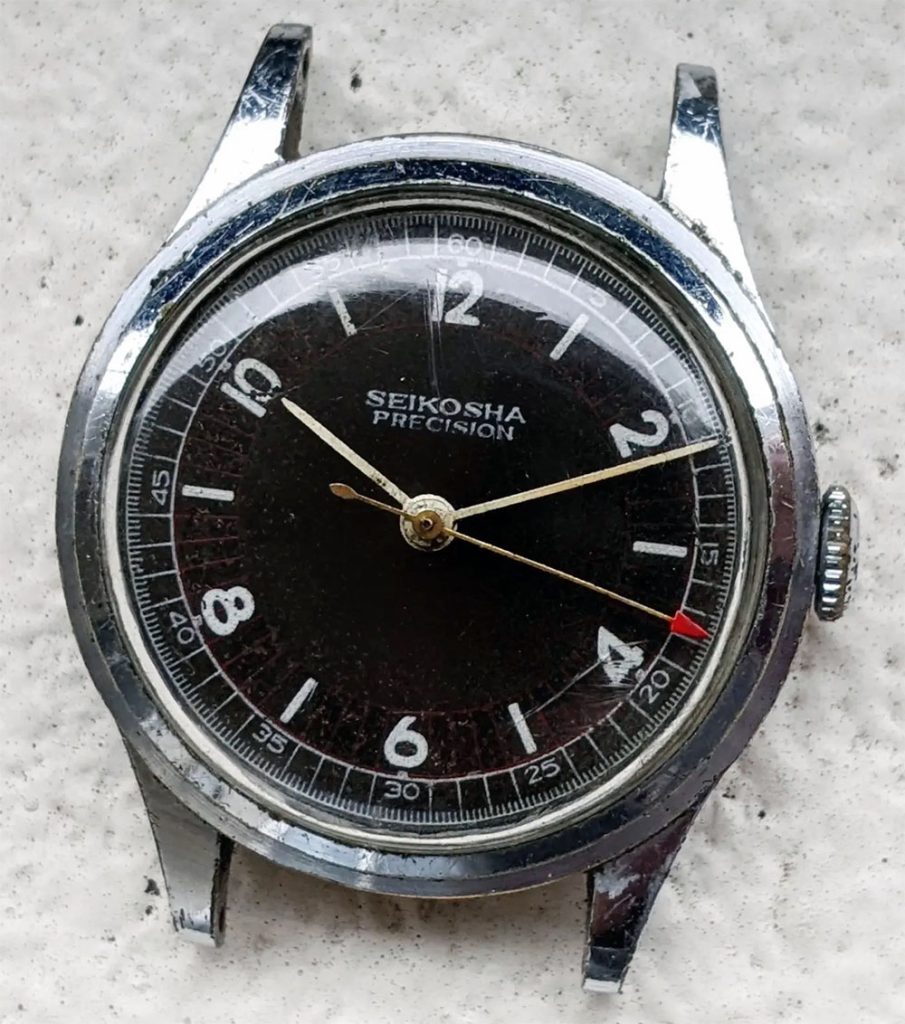
The first generation was produced with 7 and 10 jewels, while the second generation, produced from 1949, had 8 and 11 jewels.
The following image shows the movements of two models in comparison: a 7-jewel first-generation on the left and an 11-jewel second-generation on the right.
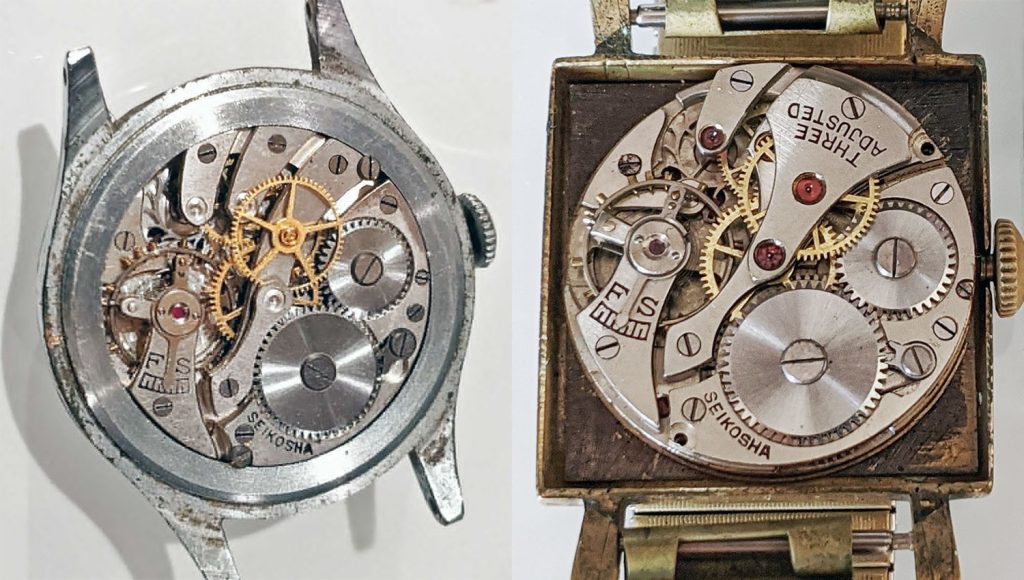
The Seiko New 10A with central seconds was produced for a relatively short period because it was effectively replaced by the Seiko Super from 1950 onwards.
Seiko 8 ligne
The Seiko 8 ligne, introduced in 1948, is a movement for women’s watches, with a wide variety of models observable in catalogs of the time.
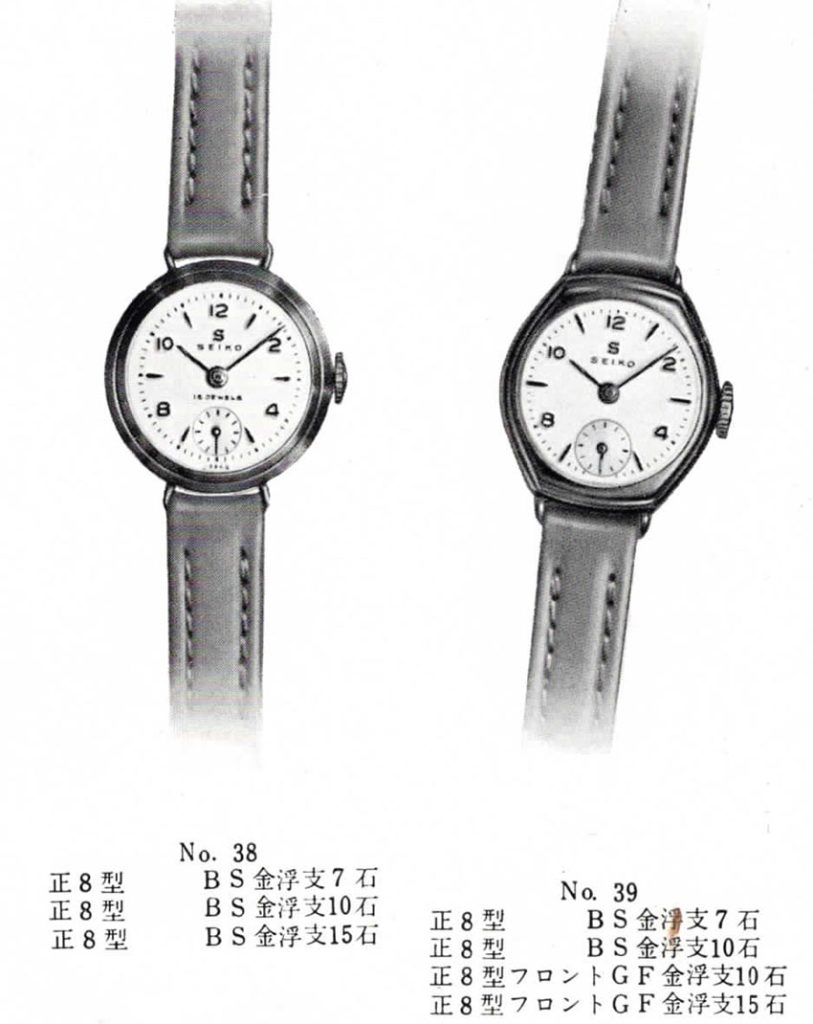
The following photo shows the 8 ligne movement, which appears similar to the Seiko New 10B introduced the same year.
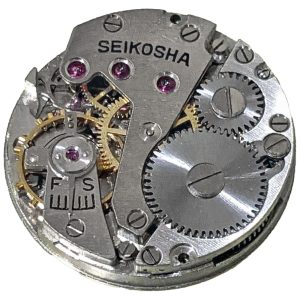
Seiko New 10B
The Seiko New 10B or “Kameido New 10” is a 10 ligne model introduced in 1948, maintaining more or less the same structure as the previous New 10A.
During the production period, which lasted a few more years than the previous New 10A (at least until 1954), a greater variety of models with very particular designs were produced.
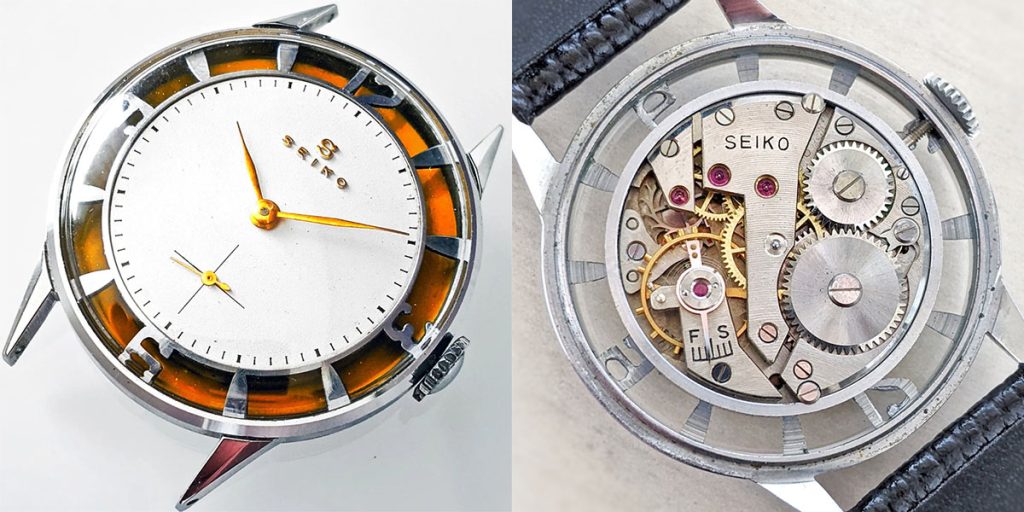
The following photo shows a Seiko Rotary, which uses the New 10B movement with a colored disc instead of the small seconds hand.
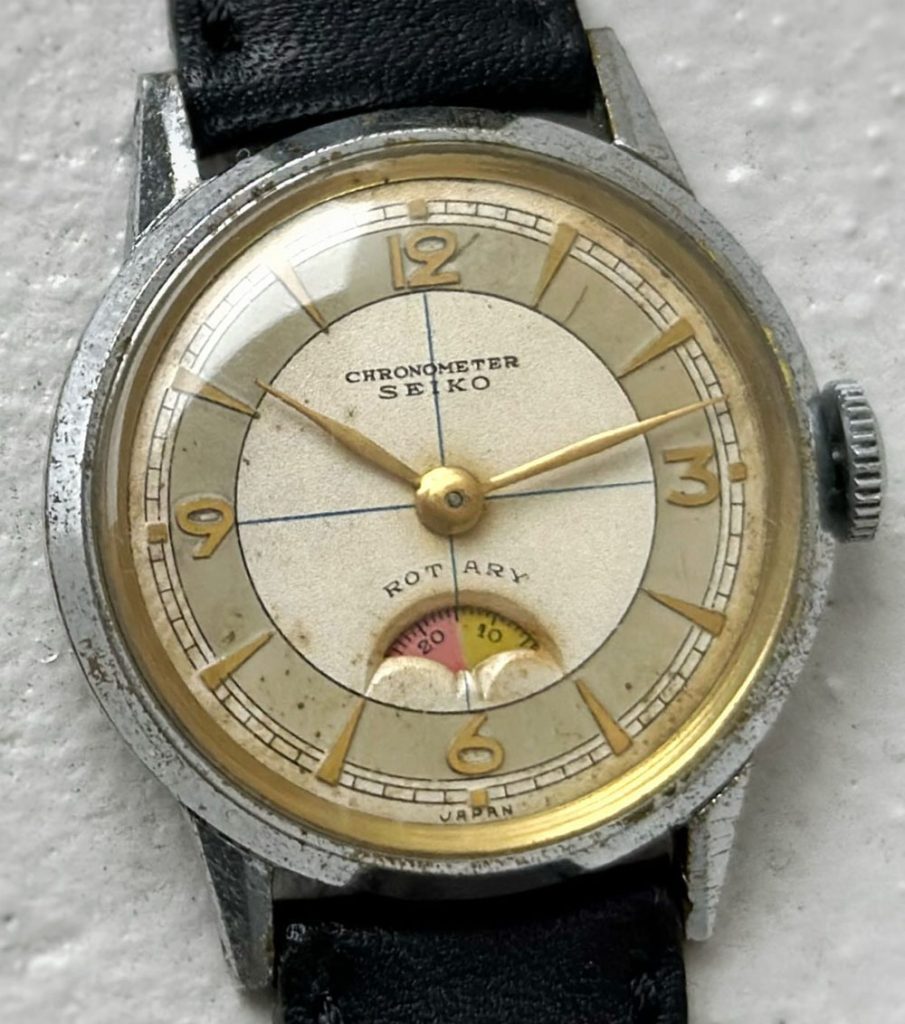
More classic models were often depicted in catalogs, such as these “Extra Flat,” one of the names used for watches based on the New 10B movement.
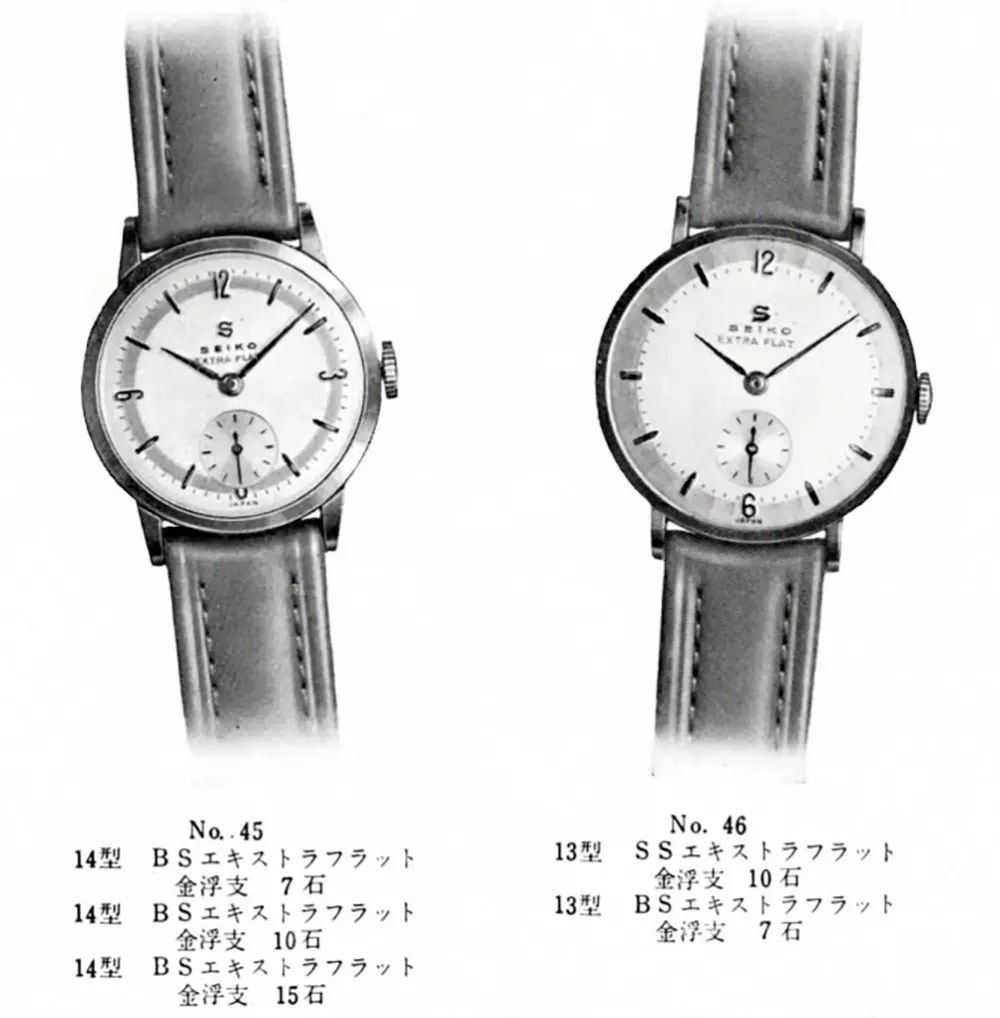
This rare Seiko New 10B example features another very particular type of dial, which can also be found on some Seiko Super models.
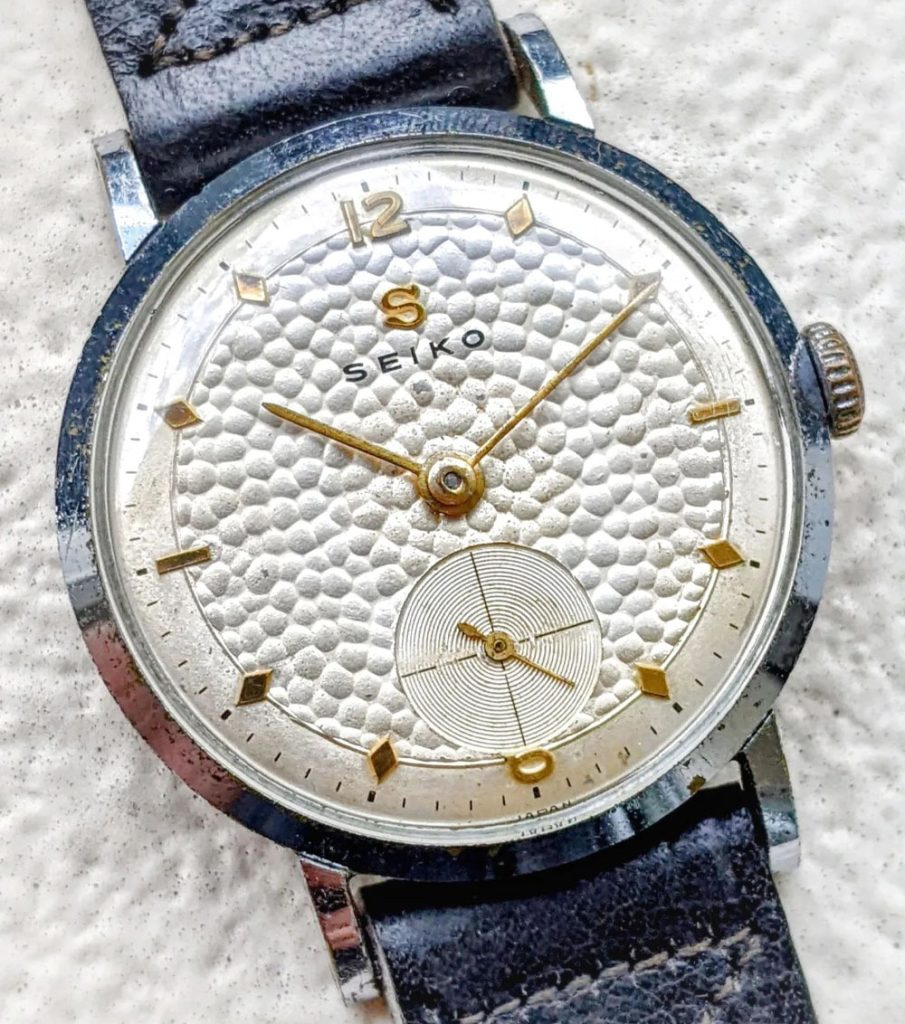
Super
The Seiko Super, introduced in 1950, is the first native Japanese movement with a central second hand. The following image shows it on the cover of a trade magazine.
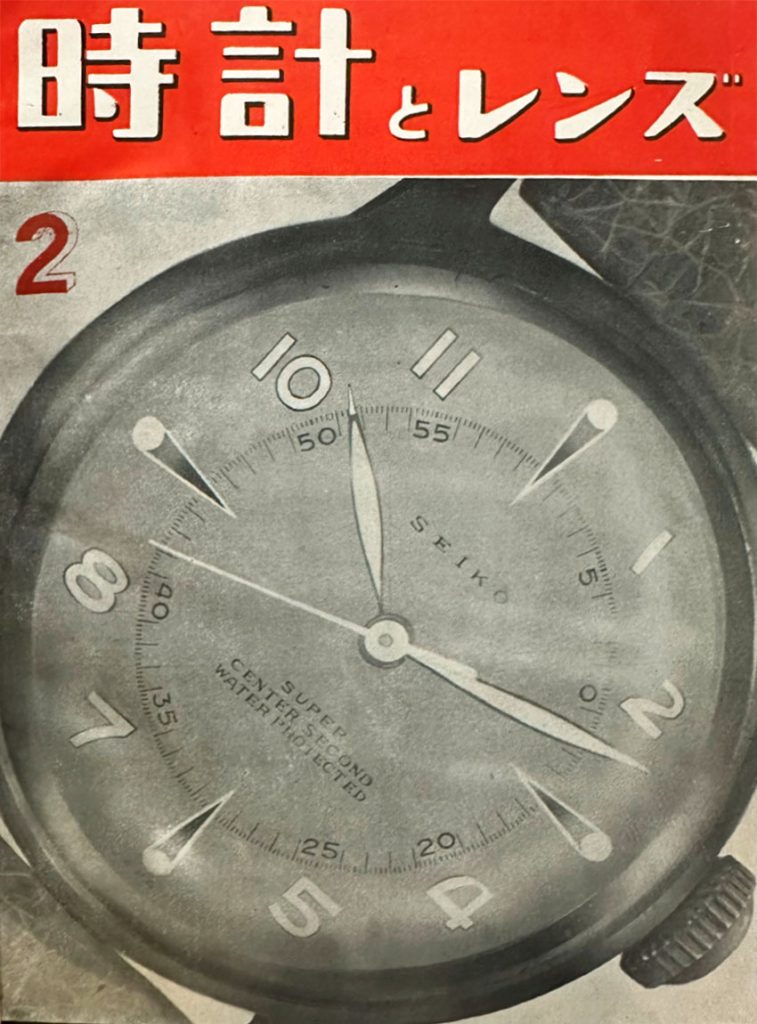
The production of the Super lasted more than 5 years, at least until 1956. A wide variety of models can be observed, in versions with 8, 9, 10, 11, 15, and 17 jewels.
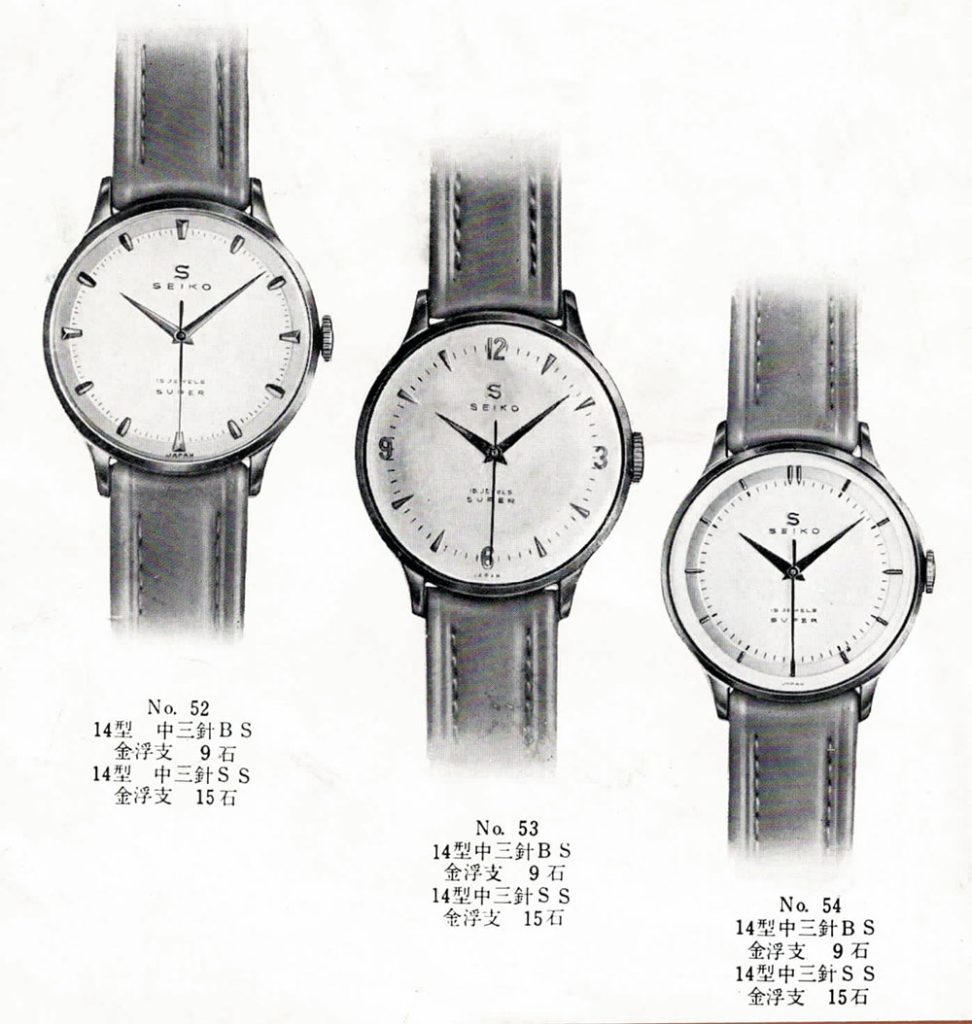
In the early 1950s, several changes in Seiko’s production standards were gradually introduced, with the implementation of a new coding and serial number system for watches. These differences can be observed between the early Super models and those produced in subsequent years.
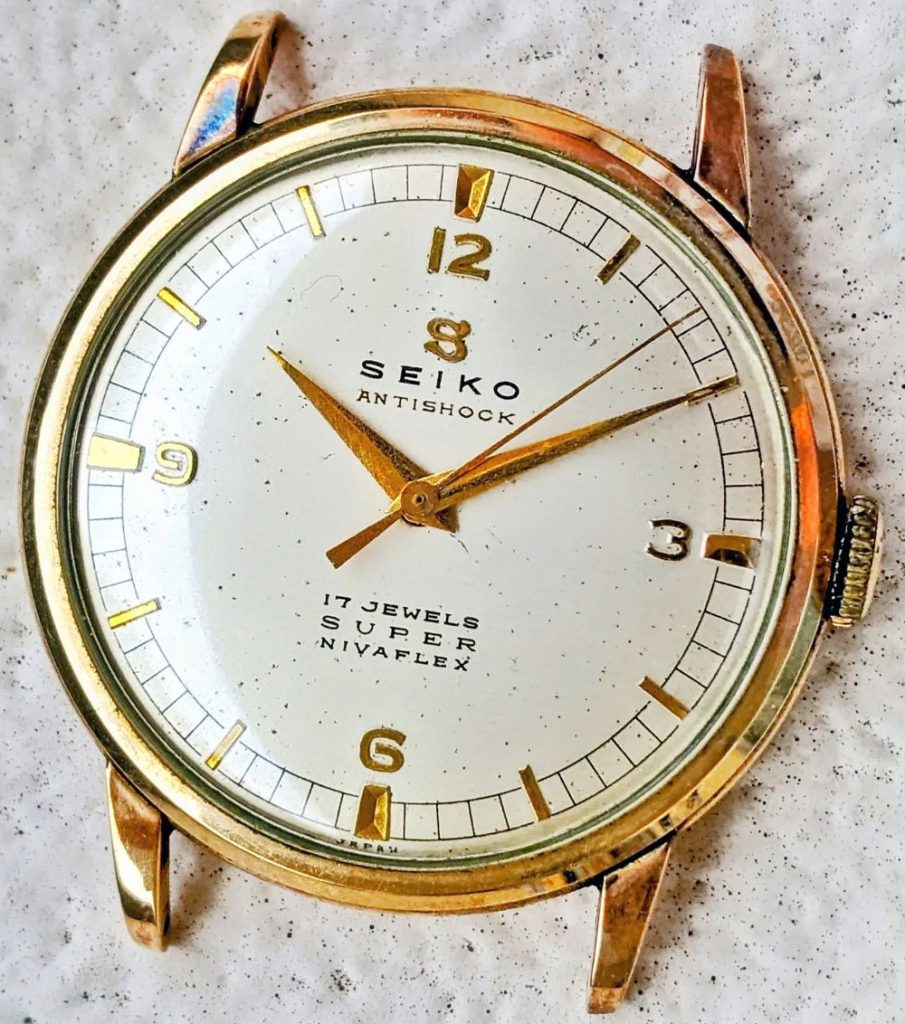
The following example is one of the few Seiko Super models with a solid gold case.
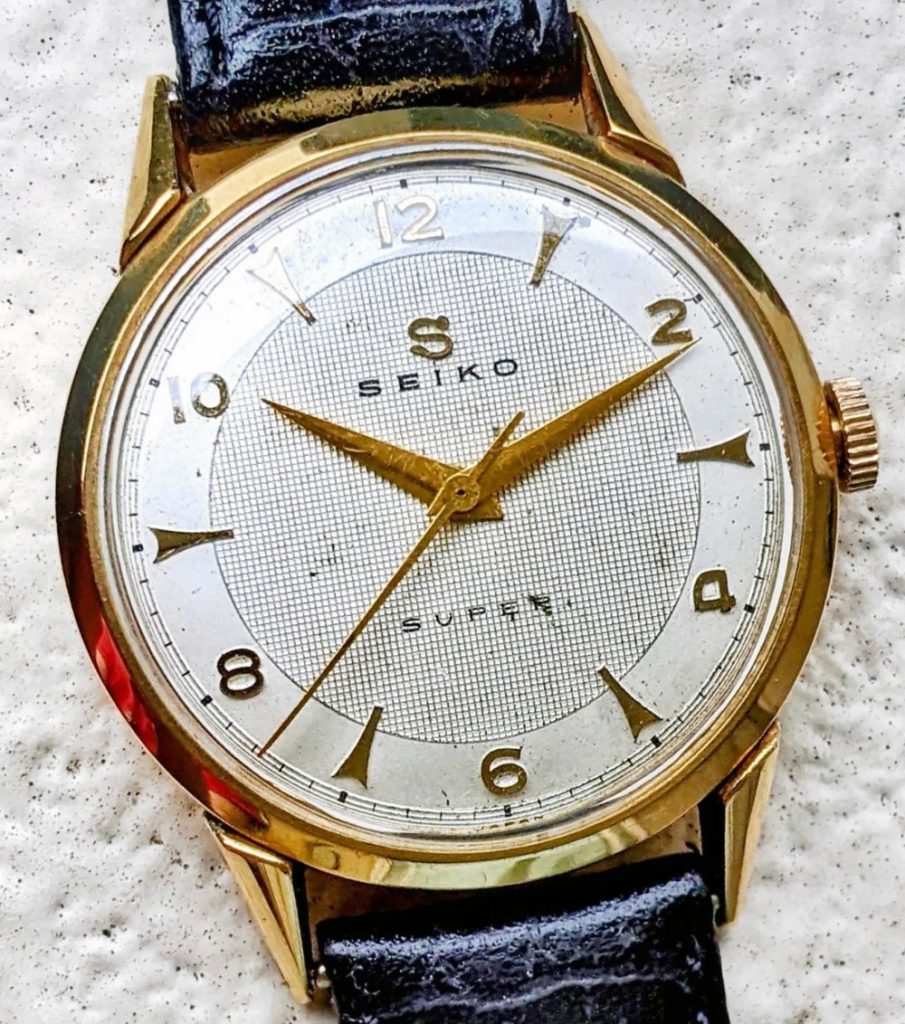
Seiko 6 ligne
In 1950, a new 6 ligne model for women was introduced.
Seiko Calendar
The first Japanese watch with a date was introduced in 1951. The Seiko Calendar features a window for the day of the week below 12 o’clock and an additional hand that serves to indicate the day of the month.
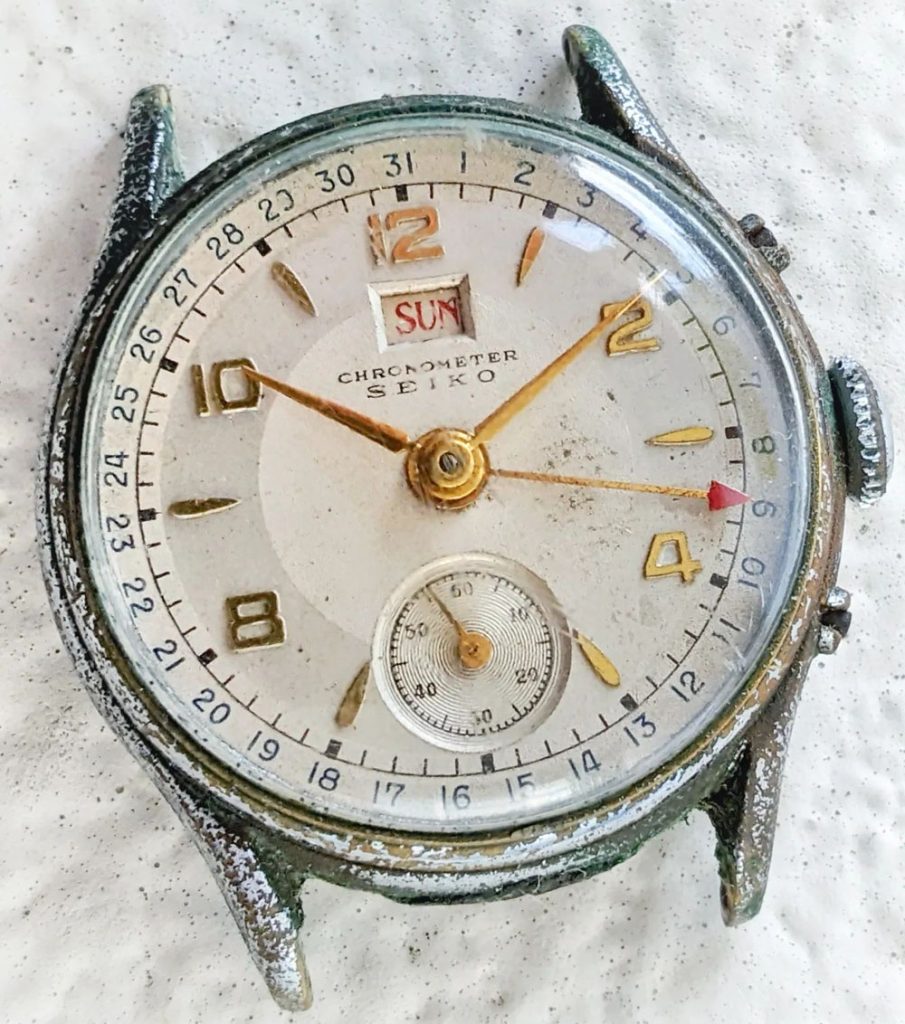
In a trade magazine from September 1951, Seiko presented a prototype with an additional window to indicate the month, which, however, seems never to have been marketed.
Super Calendar
In 1953, Seiko Super models with a date were introduced. The first model was called Auto Dator, and the date was marked by an indicator placed on a central disc.
The second model, introduced the following year (1954), was called Self Dator and featured for the first time on a Seiko watch the classic date window that later became the standard.
Also in 1954, another model called Week Dator was introduced, with the day of the week instead of the date.
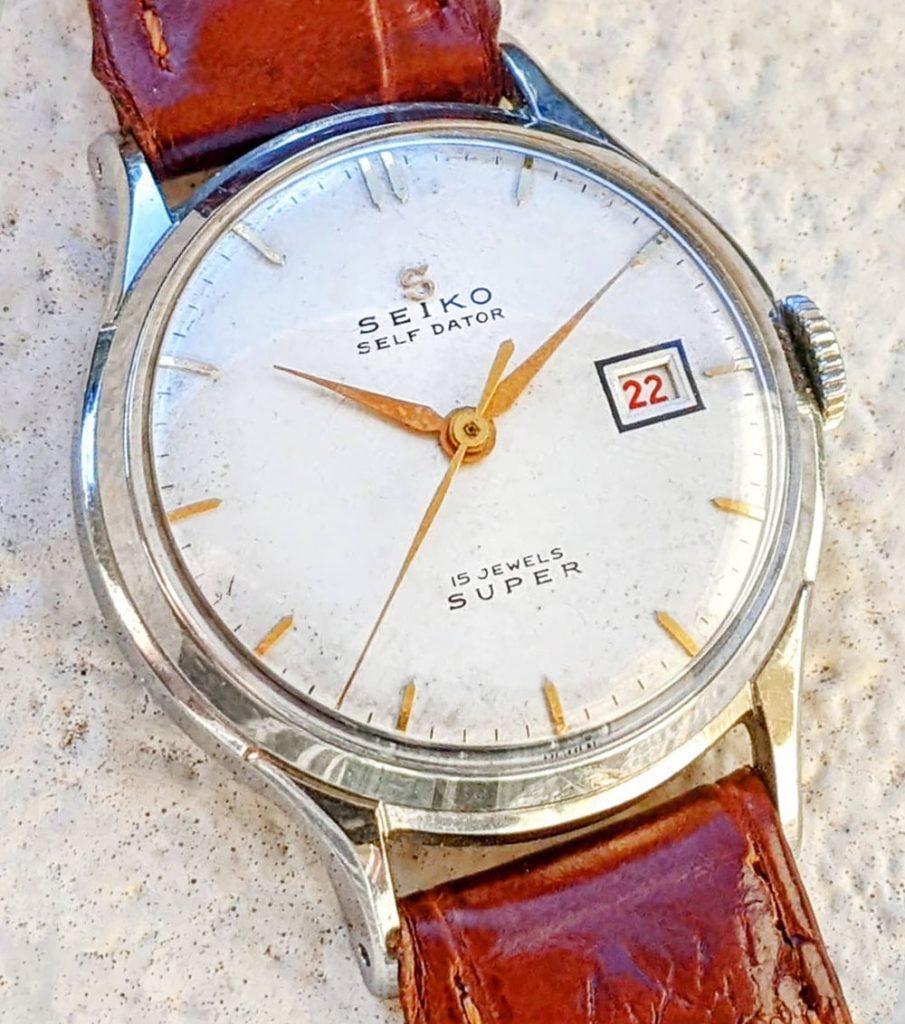
The Auto Dator had 15 jewels, the Self Dator 10 or 15 jewels, and the Week Dator 10 jewels. These are uncommon models, produced for a relatively short period.
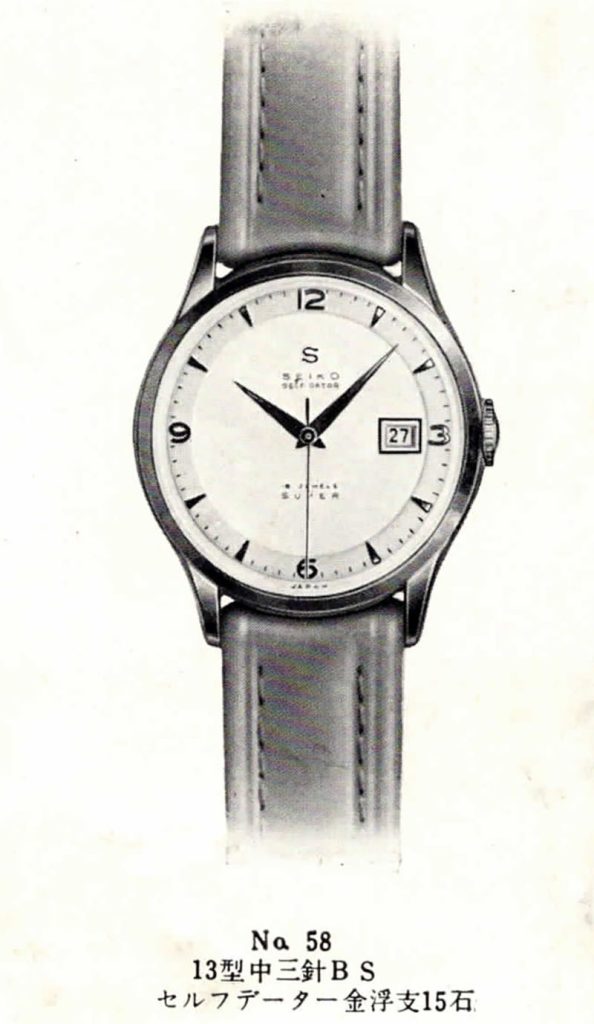
Unique
The Seiko Unique is a model introduced in 1955 that features an extremely similar structure to the Super, although it is slightly thinner.
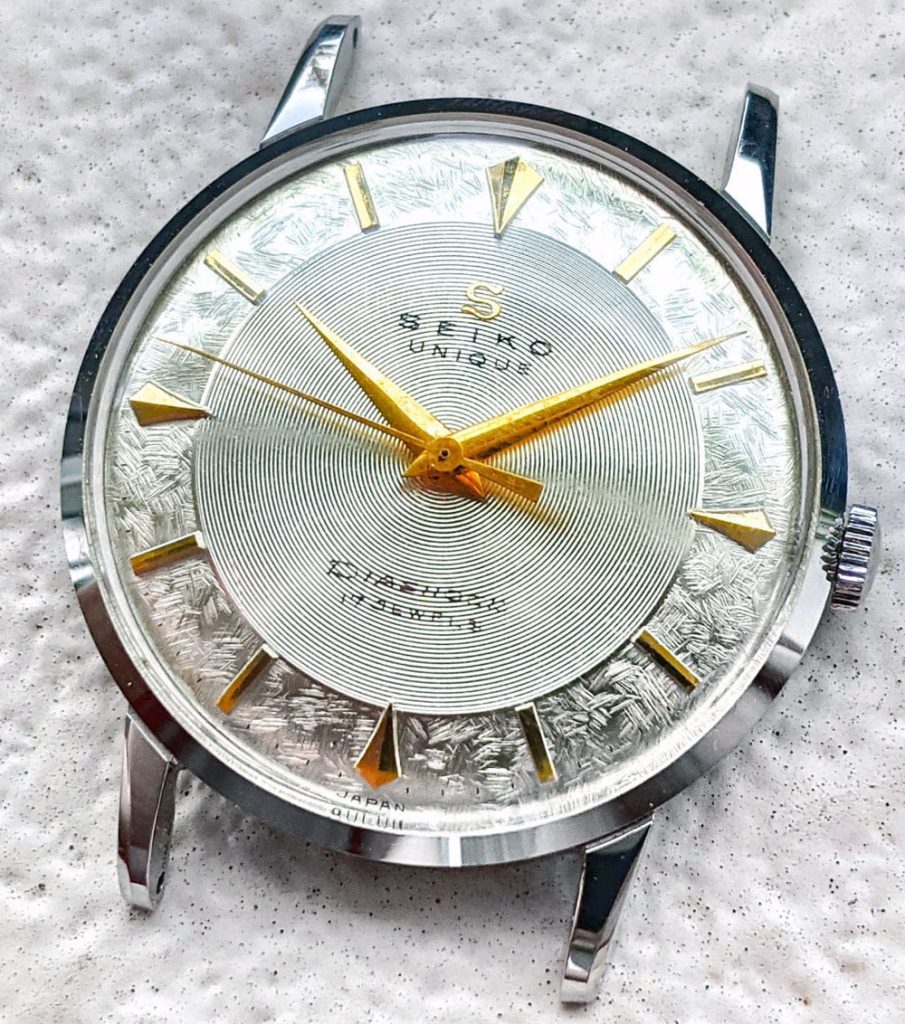
Numerous versions were produced, with 9, 15, and 17 jewels.
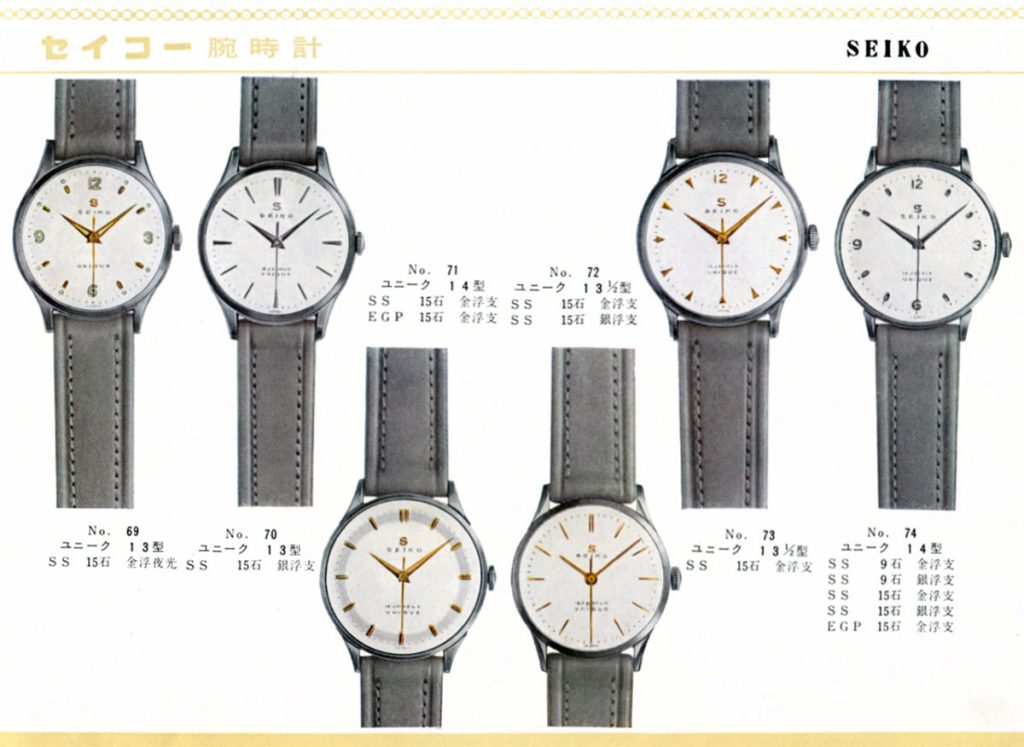
Seiko Automatic
The Seiko Automatic, introduced in August 1955, was the first wristwatch with an automatic movement produced in Japan.
It is also nicknamed “Indicator” for the characteristic power reserve indicator positioned at 12 o’clock.
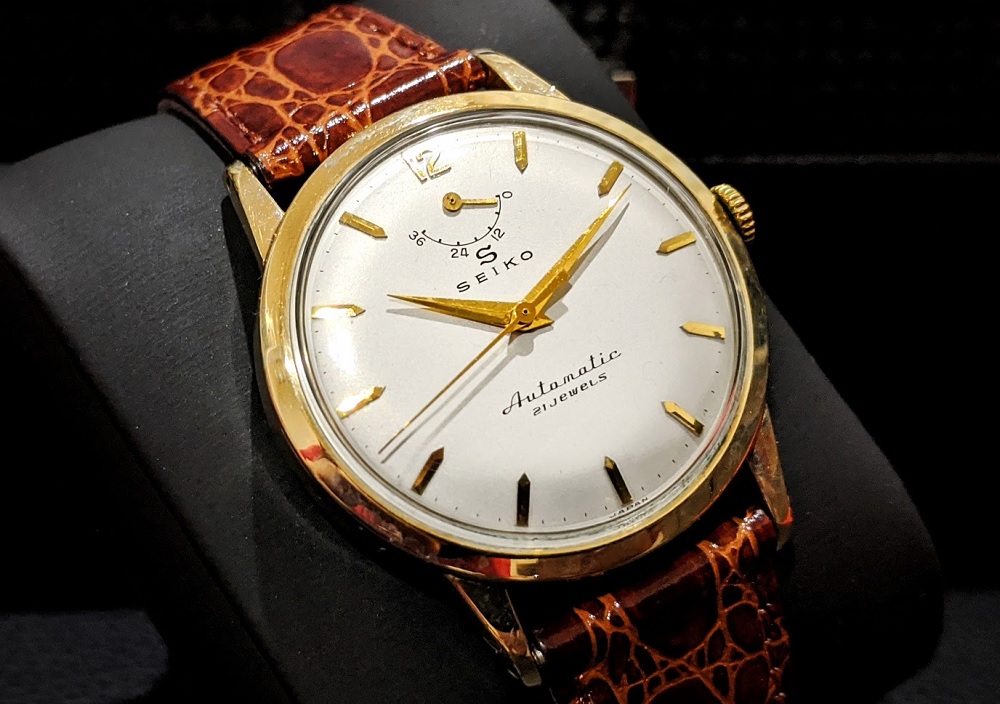
It houses the Seikosha 11A caliber, whose structure derives from the Swiss AS 1382. It was produced in 17 and 21 jewel versions, for a few years until the launch of the Gyro Marvel in 1959, made entirely in-house with the more efficient “Magic Lever” system.
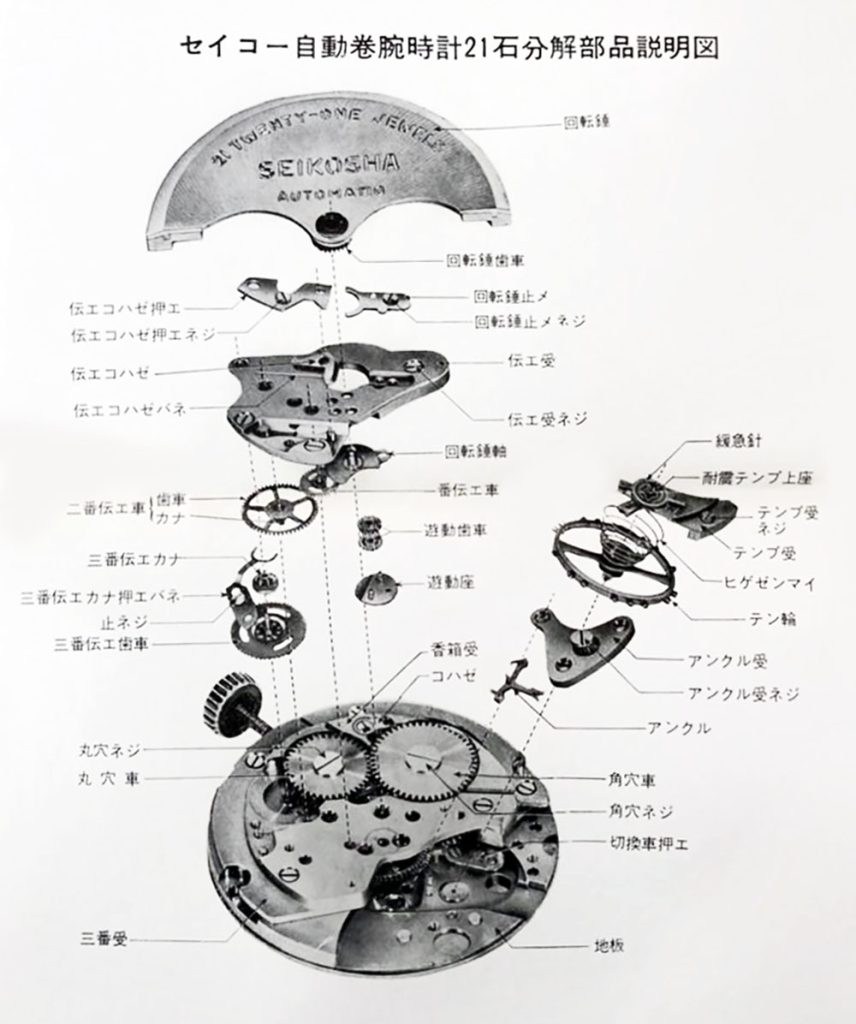
The following image depicts two of the numerous configurations of the Seiko Automatic.
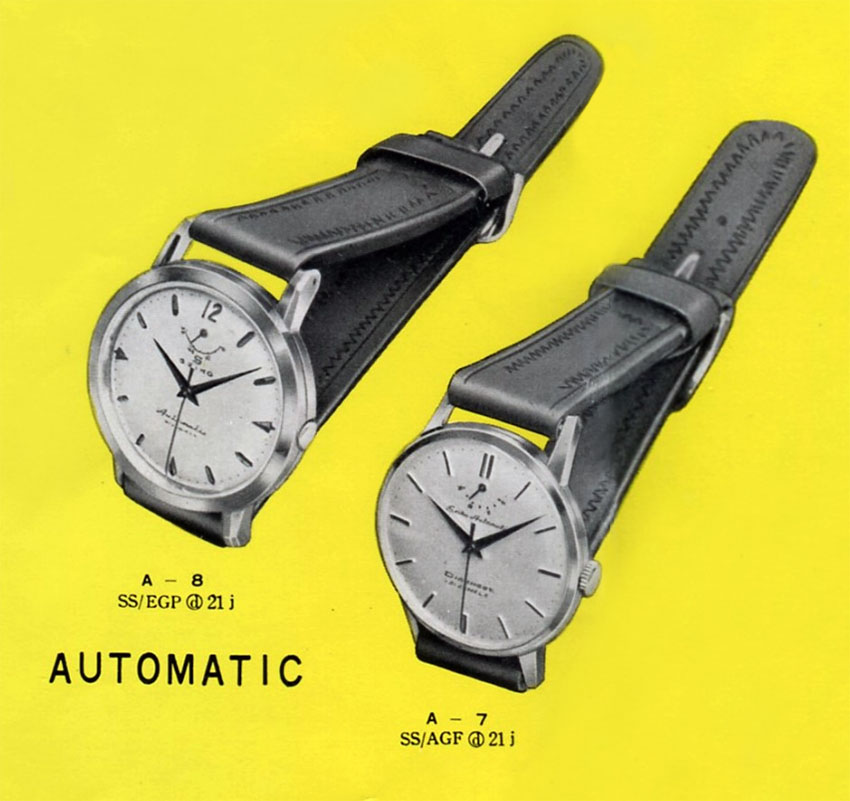
Marvel
Introduced in 1956 and produced until 1960, the Marvel was the first Seiko wristwatch developed completely in-house.
To ensure high accuracy, the movement was designed with a diameter of about 26 mm, larger than other Japanese wristwatches of the time.
During the production period, which lasted about 5 years, several versions of the Marvel with 17, 19, and 21 jewels were produced.
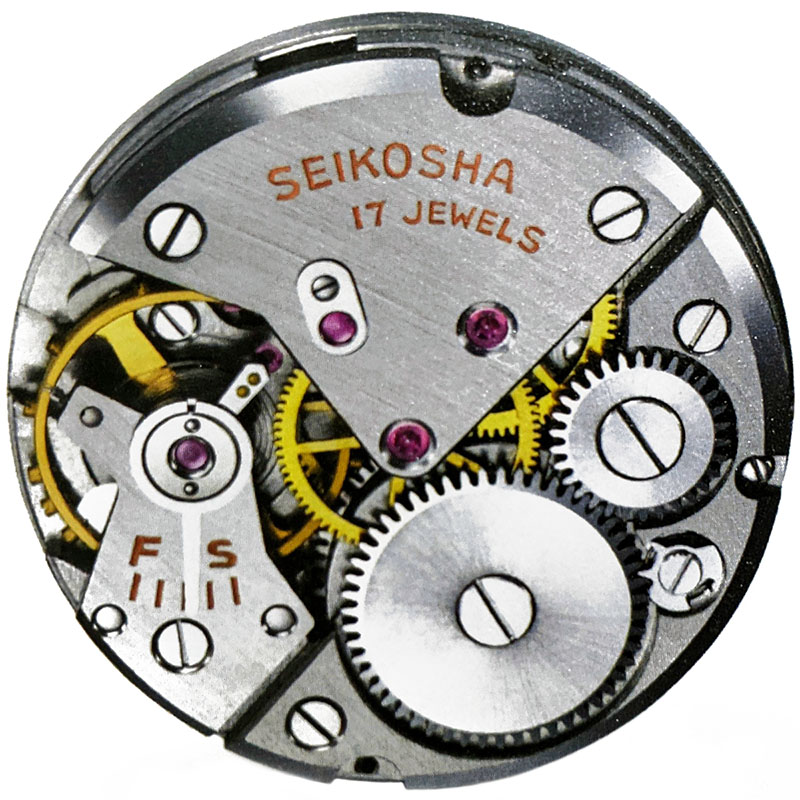
The following images depict a selection of the early models, from the 1956 Seiko catalog. Most cases were in steel or with various types of plating, but some solid gold versions were also produced.
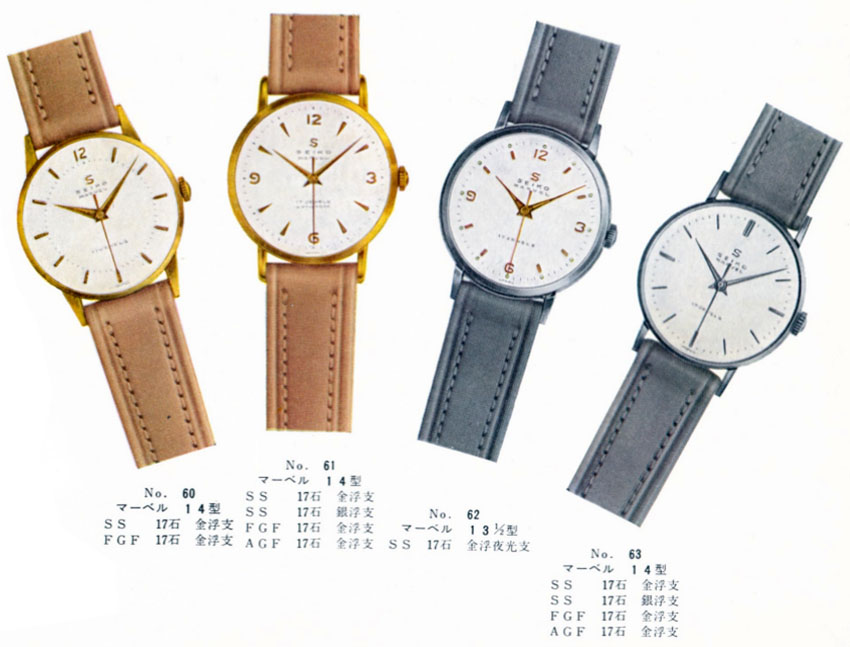
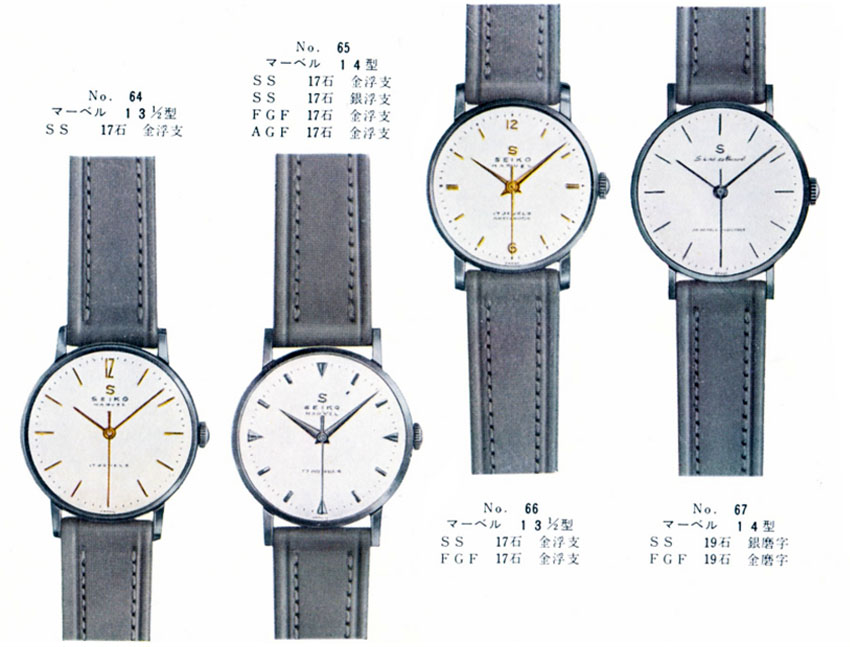
During the relatively few years of production, numerous versions followed one another rapidly, with a great variety of designs, some original and others inspired by designs already in vogue at the time. The following photo of my Seiko Marvel collection gives an idea of the variety in the models produced.
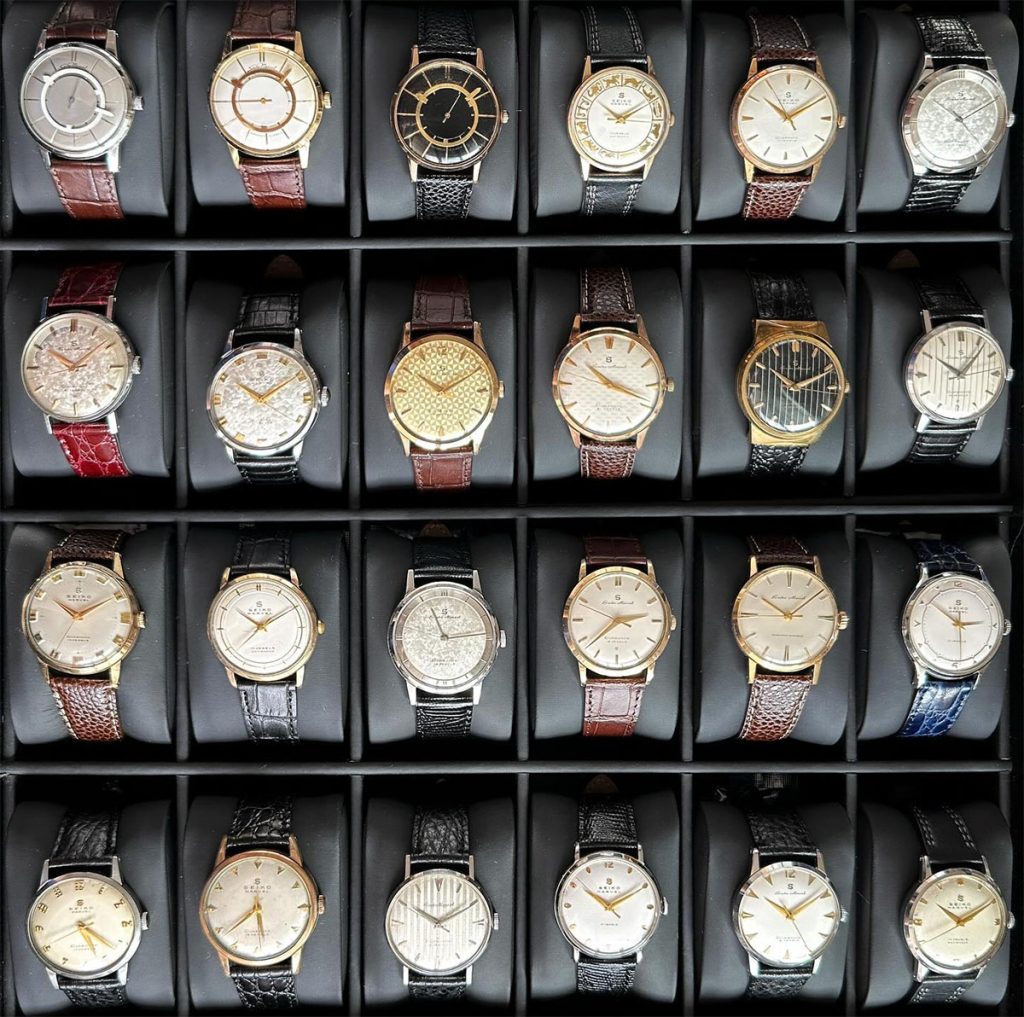
Summary table
The following table aims to summarize and provide an overview of the wristwatch models produced by Seiko from the beginning until the launch of the Marvel in 1956.
| Model | Type | Info |
|---|---|---|
| Empire 16 ligne | Mechanical hand winding | Introduced in 1913. First Seiko wristwatch, derived from the Empire pocket watch. |
| Laurel (Lofty) 12 ligne | Mechanical hand winding | Introduced in 1915. Derived from the Laurel pocket watch. |
| Mercy 13 ligne | Mechanical hand winding | Derived from the Mercy pocket watch. |
| Seiko-Moeris 9 ligne | Mechanical hand winding | Introduced in 1924. First watch with “Seiko” brand and first native wristwatch movement. |
| Seiko-Buren 10 ligne | Mechanical hand winding | Introduced in 1925. |
| Seiko-Moeris 10 ligne | Mechanical hand winding | Introduced in 1926. |
| Seiko-Moeris 8 ligne | Mechanical hand winding | Introduced in 1927. |
| Nation 9 and 10 ligne | Mechanical hand winding | Introduced in 1929. |
| Parrot 8 ligne | Mechanical hand winding | Introduced in 1930. |
| Seiko 5½ ligne | Mechanical hand winding | Introduced in 1931. First Seiko movement exclusive to women’s models. |
| Seiko 5¾ ligne | Mechanical hand winding | Introduced in 1933. |
| Seiko 10 ligne “Seikosha Precision” | Mechanical hand winding | Introduced in 1939. |
| Seiko-Moeris 10 ligne center seconds | Mechanical hand winding | Introduced in 1940. First Japanese wristwatch with center seconds. |
| Tensoku | Mechanical hand winding | Introduced in 1941. |
| Seiko 5¾ ligne | Mechanical hand winding | Introduced in 1946. First post-war Seiko model. |
| Seiko New 10A | Mechanical hand winding | Introduced in 1946. |
| Seiko New 10A central seconds | Mechanical hand winding | Introduced in 1948. |
| Seiko 8 ligne | Mechanical hand winding | Introduced in 1948. |
| Seiko New 10B | Mechanical hand winding | Introduced in 1948. |
| Super | Mechanical hand winding | Introduced in 1950. First Seiko with native center second movement. |
| Seiko 6 ligne | Mechanical hand winding | Introduced in 1950. |
| Seiko New 10A Calendar | Mechanical hand winding | Introduced in 1951. First Japanese watch with day-date complication. |
| Super Self-dater | Mechanical hand winding | Introduced in 1953. |
| Unique | Mechanical hand winding | Introduced in 1955. |
| Seiko Automatic | Mechanical automatic | Introduced in 1955. First Japanese automatic wristwatch. |
| Marvel | Mechanical hand winding | Introduced in 1956. First Seiko wristwatch developed completely in-house. |